Early Childhood Curriculum: Literature Review and Matrix
VerifiedAdded on 2023/06/07
|29
|5989
|313
AI Summary
This literature review and matrix provides insights into essential childhood curriculums required for children's learning and development. It includes references from various fields and sectors that contribute to early childhood education, planning, and activities. The article discusses the role of educators, families, and communities in promoting children's cognitive growth and development.
Contribute Materials
Your contribution can guide someone’s learning journey. Share your
documents today.
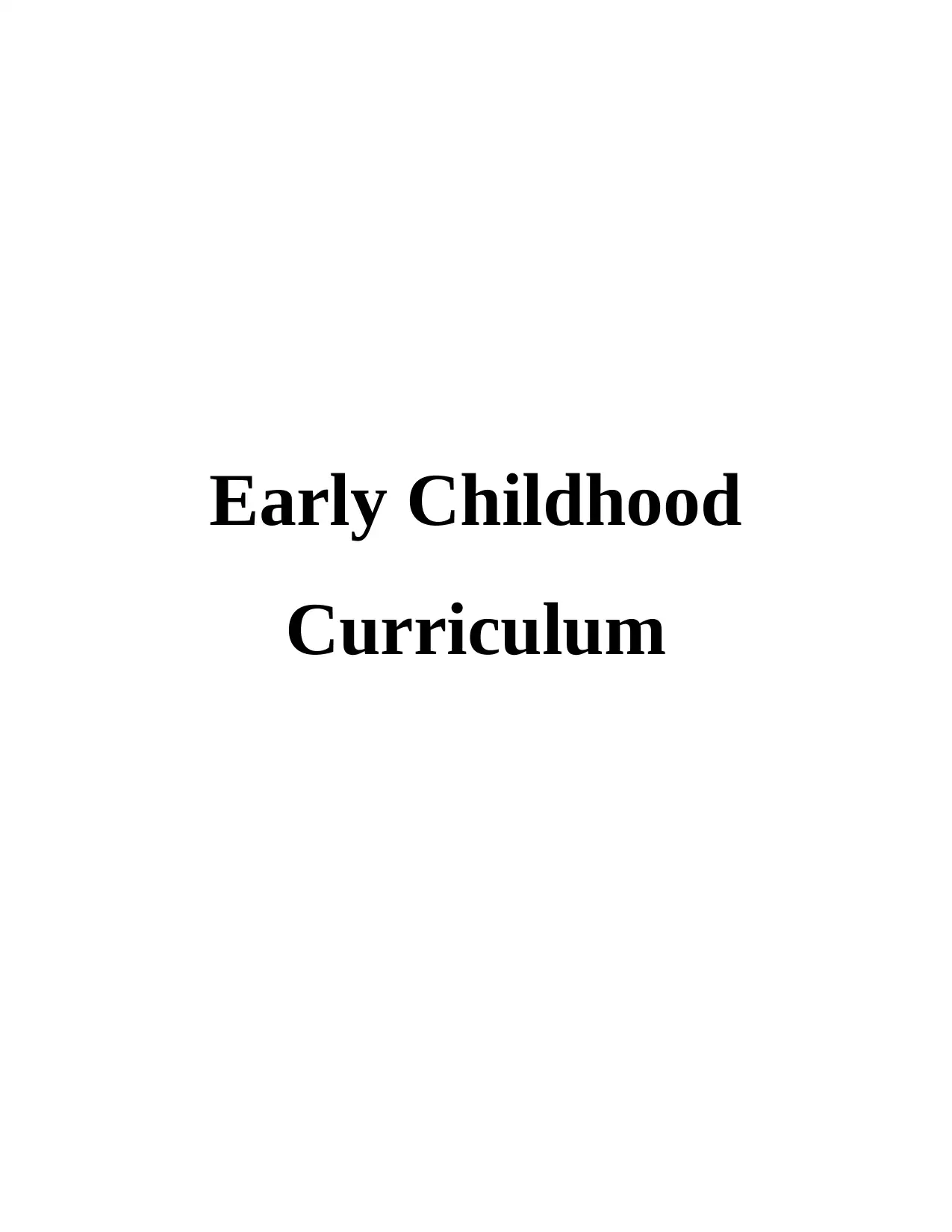
Early Childhood
Curriculum
Curriculum
Secure Best Marks with AI Grader
Need help grading? Try our AI Grader for instant feedback on your assignments.
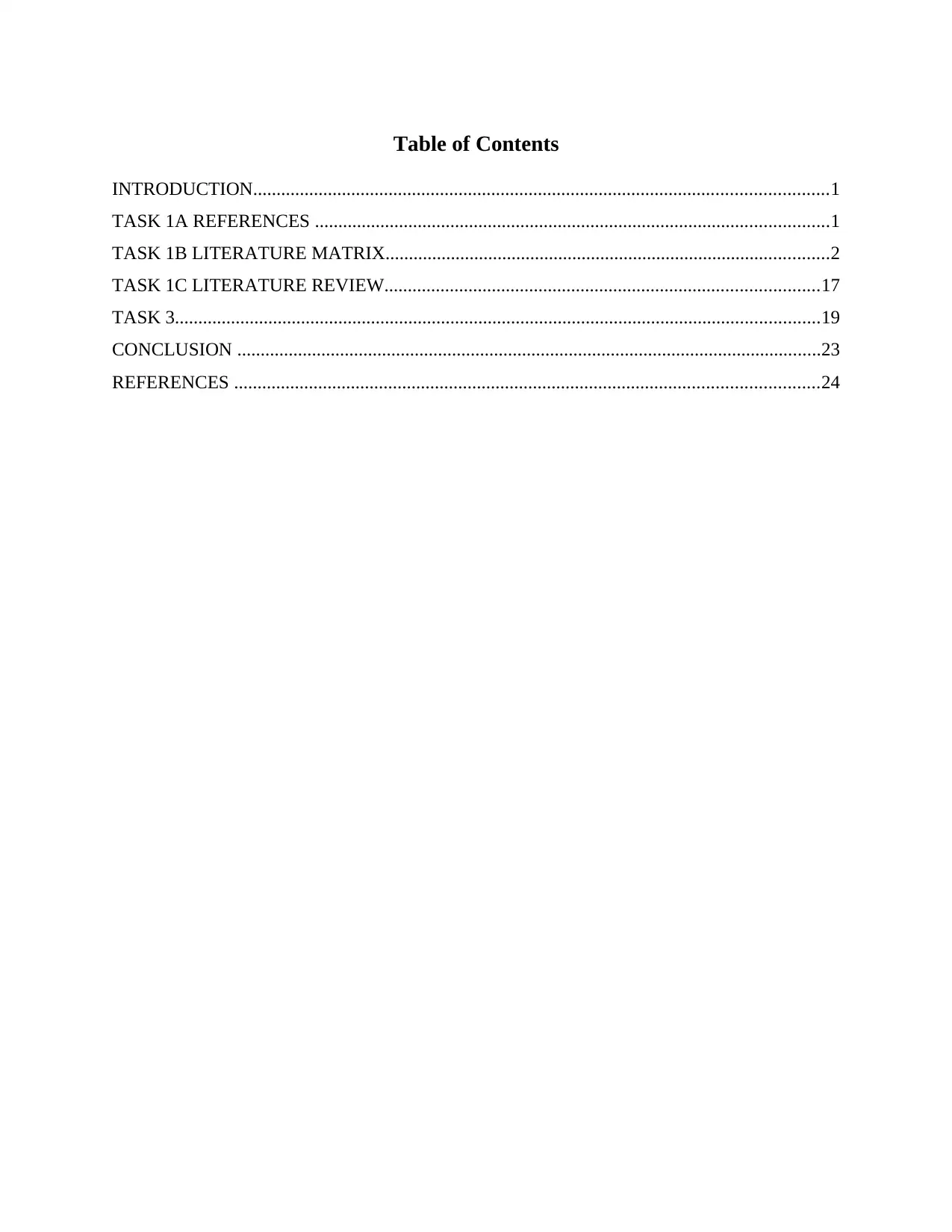
Table of Contents
INTRODUCTION...........................................................................................................................1
TASK 1A REFERENCES ..............................................................................................................1
TASK 1B LITERATURE MATRIX...............................................................................................2
TASK 1C LITERATURE REVIEW.............................................................................................17
TASK 3..........................................................................................................................................19
CONCLUSION .............................................................................................................................23
REFERENCES .............................................................................................................................24
INTRODUCTION...........................................................................................................................1
TASK 1A REFERENCES ..............................................................................................................1
TASK 1B LITERATURE MATRIX...............................................................................................2
TASK 1C LITERATURE REVIEW.............................................................................................17
TASK 3..........................................................................................................................................19
CONCLUSION .............................................................................................................................23
REFERENCES .............................................................................................................................24
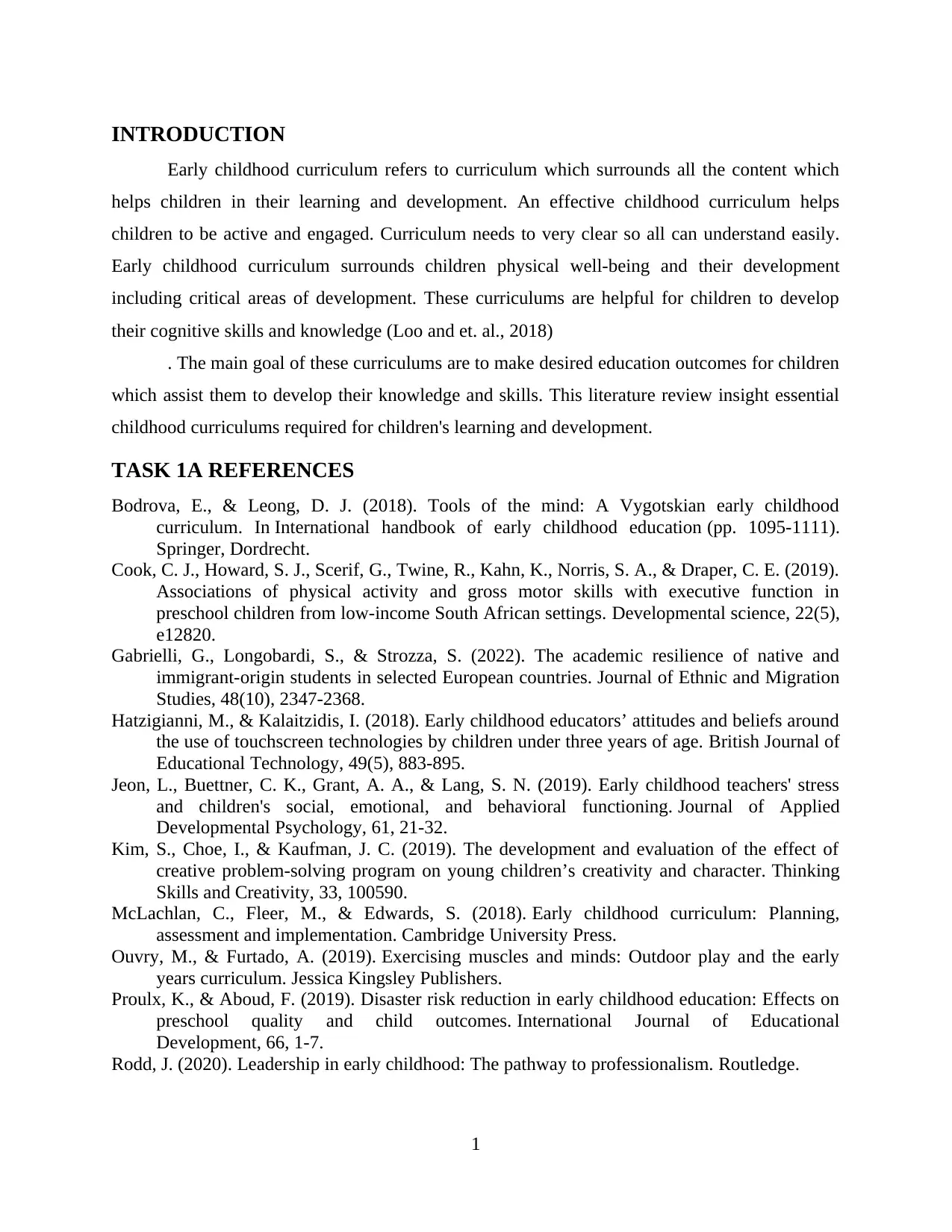
INTRODUCTION
Early childhood curriculum refers to curriculum which surrounds all the content which
helps children in their learning and development. An effective childhood curriculum helps
children to be active and engaged. Curriculum needs to very clear so all can understand easily.
Early childhood curriculum surrounds children physical well-being and their development
including critical areas of development. These curriculums are helpful for children to develop
their cognitive skills and knowledge (Loo and et. al., 2018)
. The main goal of these curriculums are to make desired education outcomes for children
which assist them to develop their knowledge and skills. This literature review insight essential
childhood curriculums required for children's learning and development.
TASK 1A REFERENCES
Bodrova, E., & Leong, D. J. (2018). Tools of the mind: A Vygotskian early childhood
curriculum. In International handbook of early childhood education (pp. 1095-1111).
Springer, Dordrecht.
Cook, C. J., Howard, S. J., Scerif, G., Twine, R., Kahn, K., Norris, S. A., & Draper, C. E. (2019).
Associations of physical activity and gross motor skills with executive function in
preschool children from low‐income South African settings. Developmental science, 22(5),
e12820.
Gabrielli, G., Longobardi, S., & Strozza, S. (2022). The academic resilience of native and
immigrant-origin students in selected European countries. Journal of Ethnic and Migration
Studies, 48(10), 2347-2368.
Hatzigianni, M., & Kalaitzidis, I. (2018). Early childhood educators’ attitudes and beliefs around
the use of touchscreen technologies by children under three years of age. British Journal of
Educational Technology, 49(5), 883-895.
Jeon, L., Buettner, C. K., Grant, A. A., & Lang, S. N. (2019). Early childhood teachers' stress
and children's social, emotional, and behavioral functioning. Journal of Applied
Developmental Psychology, 61, 21-32.
Kim, S., Choe, I., & Kaufman, J. C. (2019). The development and evaluation of the effect of
creative problem-solving program on young children’s creativity and character. Thinking
Skills and Creativity, 33, 100590.
McLachlan, C., Fleer, M., & Edwards, S. (2018). Early childhood curriculum: Planning,
assessment and implementation. Cambridge University Press.
Ouvry, M., & Furtado, A. (2019). Exercising muscles and minds: Outdoor play and the early
years curriculum. Jessica Kingsley Publishers.
Proulx, K., & Aboud, F. (2019). Disaster risk reduction in early childhood education: Effects on
preschool quality and child outcomes. International Journal of Educational
Development, 66, 1-7.
Rodd, J. (2020). Leadership in early childhood: The pathway to professionalism. Routledge.
1
Early childhood curriculum refers to curriculum which surrounds all the content which
helps children in their learning and development. An effective childhood curriculum helps
children to be active and engaged. Curriculum needs to very clear so all can understand easily.
Early childhood curriculum surrounds children physical well-being and their development
including critical areas of development. These curriculums are helpful for children to develop
their cognitive skills and knowledge (Loo and et. al., 2018)
. The main goal of these curriculums are to make desired education outcomes for children
which assist them to develop their knowledge and skills. This literature review insight essential
childhood curriculums required for children's learning and development.
TASK 1A REFERENCES
Bodrova, E., & Leong, D. J. (2018). Tools of the mind: A Vygotskian early childhood
curriculum. In International handbook of early childhood education (pp. 1095-1111).
Springer, Dordrecht.
Cook, C. J., Howard, S. J., Scerif, G., Twine, R., Kahn, K., Norris, S. A., & Draper, C. E. (2019).
Associations of physical activity and gross motor skills with executive function in
preschool children from low‐income South African settings. Developmental science, 22(5),
e12820.
Gabrielli, G., Longobardi, S., & Strozza, S. (2022). The academic resilience of native and
immigrant-origin students in selected European countries. Journal of Ethnic and Migration
Studies, 48(10), 2347-2368.
Hatzigianni, M., & Kalaitzidis, I. (2018). Early childhood educators’ attitudes and beliefs around
the use of touchscreen technologies by children under three years of age. British Journal of
Educational Technology, 49(5), 883-895.
Jeon, L., Buettner, C. K., Grant, A. A., & Lang, S. N. (2019). Early childhood teachers' stress
and children's social, emotional, and behavioral functioning. Journal of Applied
Developmental Psychology, 61, 21-32.
Kim, S., Choe, I., & Kaufman, J. C. (2019). The development and evaluation of the effect of
creative problem-solving program on young children’s creativity and character. Thinking
Skills and Creativity, 33, 100590.
McLachlan, C., Fleer, M., & Edwards, S. (2018). Early childhood curriculum: Planning,
assessment and implementation. Cambridge University Press.
Ouvry, M., & Furtado, A. (2019). Exercising muscles and minds: Outdoor play and the early
years curriculum. Jessica Kingsley Publishers.
Proulx, K., & Aboud, F. (2019). Disaster risk reduction in early childhood education: Effects on
preschool quality and child outcomes. International Journal of Educational
Development, 66, 1-7.
Rodd, J. (2020). Leadership in early childhood: The pathway to professionalism. Routledge.
1
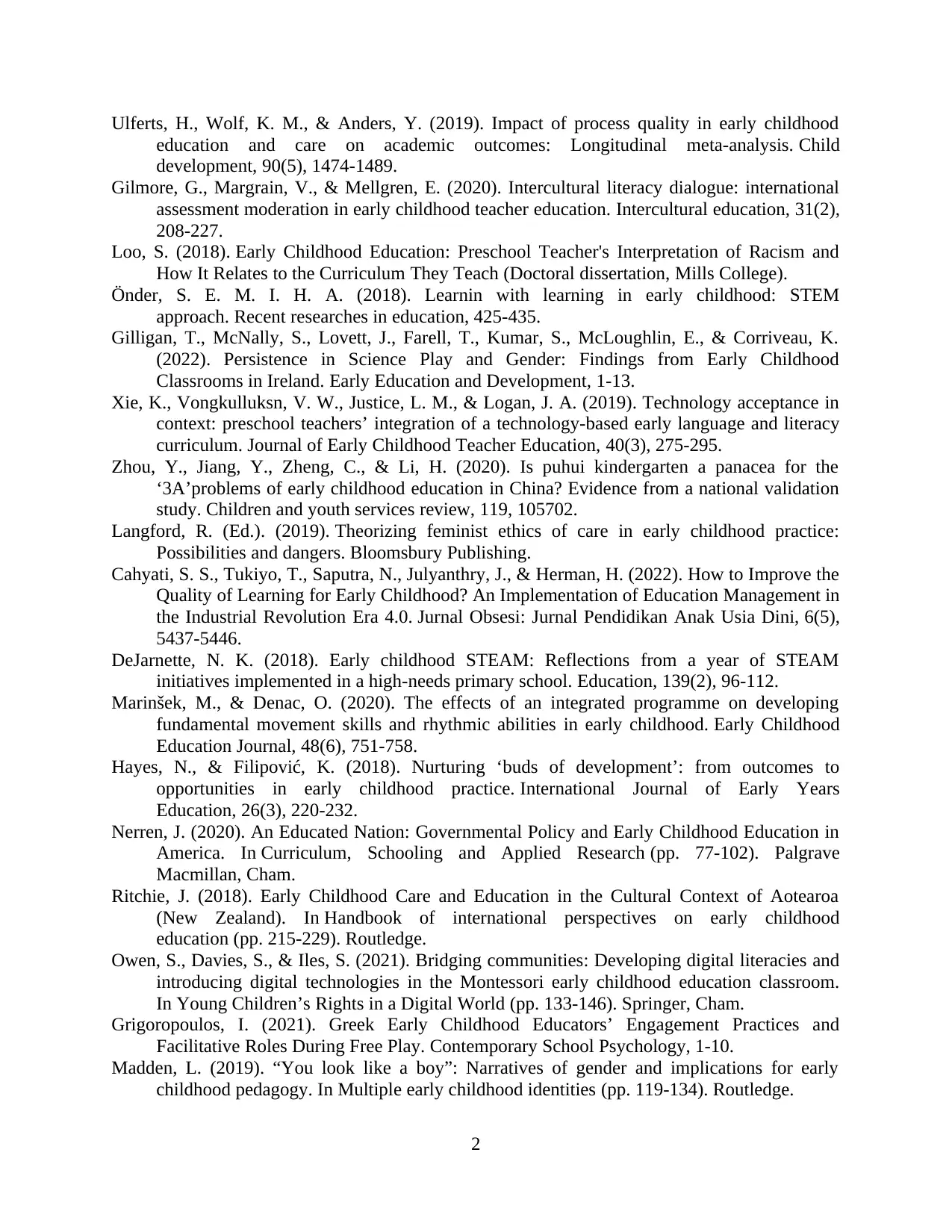
Ulferts, H., Wolf, K. M., & Anders, Y. (2019). Impact of process quality in early childhood
education and care on academic outcomes: Longitudinal meta‐analysis. Child
development, 90(5), 1474-1489.
Gilmore, G., Margrain, V., & Mellgren, E. (2020). Intercultural literacy dialogue: international
assessment moderation in early childhood teacher education. Intercultural education, 31(2),
208-227.
Loo, S. (2018). Early Childhood Education: Preschool Teacher's Interpretation of Racism and
How It Relates to the Curriculum They Teach (Doctoral dissertation, Mills College).
Önder, S. E. M. I. H. A. (2018). Learnin with learning in early childhood: STEM
approach. Recent researches in education, 425-435.
Gilligan, T., McNally, S., Lovett, J., Farell, T., Kumar, S., McLoughlin, E., & Corriveau, K.
(2022). Persistence in Science Play and Gender: Findings from Early Childhood
Classrooms in Ireland. Early Education and Development, 1-13.
Xie, K., Vongkulluksn, V. W., Justice, L. M., & Logan, J. A. (2019). Technology acceptance in
context: preschool teachers’ integration of a technology-based early language and literacy
curriculum. Journal of Early Childhood Teacher Education, 40(3), 275-295.
Zhou, Y., Jiang, Y., Zheng, C., & Li, H. (2020). Is puhui kindergarten a panacea for the
‘3A’problems of early childhood education in China? Evidence from a national validation
study. Children and youth services review, 119, 105702.
Langford, R. (Ed.). (2019). Theorizing feminist ethics of care in early childhood practice:
Possibilities and dangers. Bloomsbury Publishing.
Cahyati, S. S., Tukiyo, T., Saputra, N., Julyanthry, J., & Herman, H. (2022). How to Improve the
Quality of Learning for Early Childhood? An Implementation of Education Management in
the Industrial Revolution Era 4.0. Jurnal Obsesi: Jurnal Pendidikan Anak Usia Dini, 6(5),
5437-5446.
DeJarnette, N. K. (2018). Early childhood STEAM: Reflections from a year of STEAM
initiatives implemented in a high-needs primary school. Education, 139(2), 96-112.
Marinšek, M., & Denac, O. (2020). The effects of an integrated programme on developing
fundamental movement skills and rhythmic abilities in early childhood. Early Childhood
Education Journal, 48(6), 751-758.
Hayes, N., & Filipović, K. (2018). Nurturing ‘buds of development’: from outcomes to
opportunities in early childhood practice. International Journal of Early Years
Education, 26(3), 220-232.
Nerren, J. (2020). An Educated Nation: Governmental Policy and Early Childhood Education in
America. In Curriculum, Schooling and Applied Research (pp. 77-102). Palgrave
Macmillan, Cham.
Ritchie, J. (2018). Early Childhood Care and Education in the Cultural Context of Aotearoa
(New Zealand). In Handbook of international perspectives on early childhood
education (pp. 215-229). Routledge.
Owen, S., Davies, S., & Iles, S. (2021). Bridging communities: Developing digital literacies and
introducing digital technologies in the Montessori early childhood education classroom.
In Young Children’s Rights in a Digital World (pp. 133-146). Springer, Cham.
Grigoropoulos, I. (2021). Greek Early Childhood Educators’ Engagement Practices and
Facilitative Roles During Free Play. Contemporary School Psychology, 1-10.
Madden, L. (2019). “You look like a boy”: Narratives of gender and implications for early
childhood pedagogy. In Multiple early childhood identities (pp. 119-134). Routledge.
2
education and care on academic outcomes: Longitudinal meta‐analysis. Child
development, 90(5), 1474-1489.
Gilmore, G., Margrain, V., & Mellgren, E. (2020). Intercultural literacy dialogue: international
assessment moderation in early childhood teacher education. Intercultural education, 31(2),
208-227.
Loo, S. (2018). Early Childhood Education: Preschool Teacher's Interpretation of Racism and
How It Relates to the Curriculum They Teach (Doctoral dissertation, Mills College).
Önder, S. E. M. I. H. A. (2018). Learnin with learning in early childhood: STEM
approach. Recent researches in education, 425-435.
Gilligan, T., McNally, S., Lovett, J., Farell, T., Kumar, S., McLoughlin, E., & Corriveau, K.
(2022). Persistence in Science Play and Gender: Findings from Early Childhood
Classrooms in Ireland. Early Education and Development, 1-13.
Xie, K., Vongkulluksn, V. W., Justice, L. M., & Logan, J. A. (2019). Technology acceptance in
context: preschool teachers’ integration of a technology-based early language and literacy
curriculum. Journal of Early Childhood Teacher Education, 40(3), 275-295.
Zhou, Y., Jiang, Y., Zheng, C., & Li, H. (2020). Is puhui kindergarten a panacea for the
‘3A’problems of early childhood education in China? Evidence from a national validation
study. Children and youth services review, 119, 105702.
Langford, R. (Ed.). (2019). Theorizing feminist ethics of care in early childhood practice:
Possibilities and dangers. Bloomsbury Publishing.
Cahyati, S. S., Tukiyo, T., Saputra, N., Julyanthry, J., & Herman, H. (2022). How to Improve the
Quality of Learning for Early Childhood? An Implementation of Education Management in
the Industrial Revolution Era 4.0. Jurnal Obsesi: Jurnal Pendidikan Anak Usia Dini, 6(5),
5437-5446.
DeJarnette, N. K. (2018). Early childhood STEAM: Reflections from a year of STEAM
initiatives implemented in a high-needs primary school. Education, 139(2), 96-112.
Marinšek, M., & Denac, O. (2020). The effects of an integrated programme on developing
fundamental movement skills and rhythmic abilities in early childhood. Early Childhood
Education Journal, 48(6), 751-758.
Hayes, N., & Filipović, K. (2018). Nurturing ‘buds of development’: from outcomes to
opportunities in early childhood practice. International Journal of Early Years
Education, 26(3), 220-232.
Nerren, J. (2020). An Educated Nation: Governmental Policy and Early Childhood Education in
America. In Curriculum, Schooling and Applied Research (pp. 77-102). Palgrave
Macmillan, Cham.
Ritchie, J. (2018). Early Childhood Care and Education in the Cultural Context of Aotearoa
(New Zealand). In Handbook of international perspectives on early childhood
education (pp. 215-229). Routledge.
Owen, S., Davies, S., & Iles, S. (2021). Bridging communities: Developing digital literacies and
introducing digital technologies in the Montessori early childhood education classroom.
In Young Children’s Rights in a Digital World (pp. 133-146). Springer, Cham.
Grigoropoulos, I. (2021). Greek Early Childhood Educators’ Engagement Practices and
Facilitative Roles During Free Play. Contemporary School Psychology, 1-10.
Madden, L. (2019). “You look like a boy”: Narratives of gender and implications for early
childhood pedagogy. In Multiple early childhood identities (pp. 119-134). Routledge.
2
Secure Best Marks with AI Grader
Need help grading? Try our AI Grader for instant feedback on your assignments.
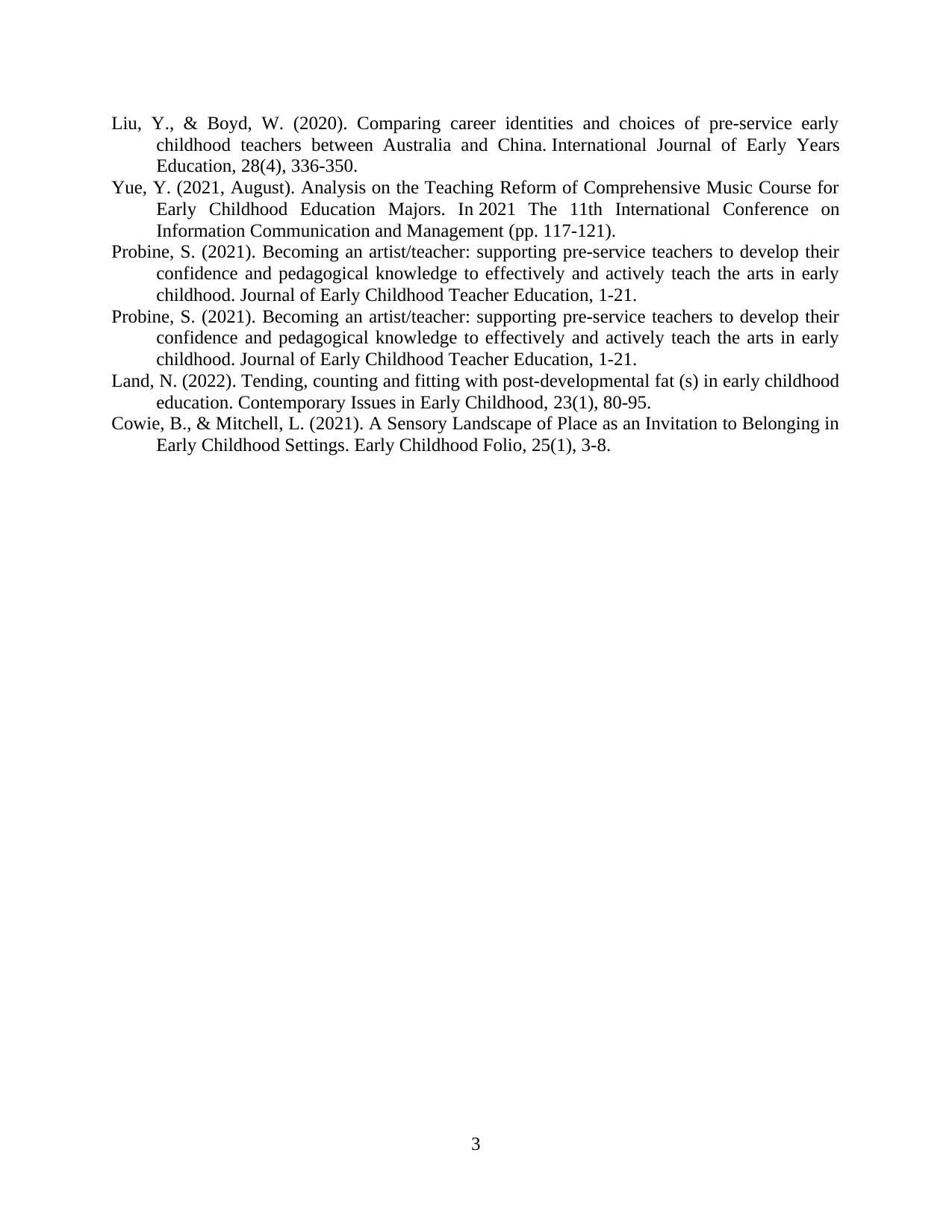
Liu, Y., & Boyd, W. (2020). Comparing career identities and choices of pre-service early
childhood teachers between Australia and China. International Journal of Early Years
Education, 28(4), 336-350.
Yue, Y. (2021, August). Analysis on the Teaching Reform of Comprehensive Music Course for
Early Childhood Education Majors. In 2021 The 11th International Conference on
Information Communication and Management (pp. 117-121).
Probine, S. (2021). Becoming an artist/teacher: supporting pre-service teachers to develop their
confidence and pedagogical knowledge to effectively and actively teach the arts in early
childhood. Journal of Early Childhood Teacher Education, 1-21.
Probine, S. (2021). Becoming an artist/teacher: supporting pre-service teachers to develop their
confidence and pedagogical knowledge to effectively and actively teach the arts in early
childhood. Journal of Early Childhood Teacher Education, 1-21.
Land, N. (2022). Tending, counting and fitting with post-developmental fat (s) in early childhood
education. Contemporary Issues in Early Childhood, 23(1), 80-95.
Cowie, B., & Mitchell, L. (2021). A Sensory Landscape of Place as an Invitation to Belonging in
Early Childhood Settings. Early Childhood Folio, 25(1), 3-8.
3
childhood teachers between Australia and China. International Journal of Early Years
Education, 28(4), 336-350.
Yue, Y. (2021, August). Analysis on the Teaching Reform of Comprehensive Music Course for
Early Childhood Education Majors. In 2021 The 11th International Conference on
Information Communication and Management (pp. 117-121).
Probine, S. (2021). Becoming an artist/teacher: supporting pre-service teachers to develop their
confidence and pedagogical knowledge to effectively and actively teach the arts in early
childhood. Journal of Early Childhood Teacher Education, 1-21.
Probine, S. (2021). Becoming an artist/teacher: supporting pre-service teachers to develop their
confidence and pedagogical knowledge to effectively and actively teach the arts in early
childhood. Journal of Early Childhood Teacher Education, 1-21.
Land, N. (2022). Tending, counting and fitting with post-developmental fat (s) in early childhood
education. Contemporary Issues in Early Childhood, 23(1), 80-95.
Cowie, B., & Mitchell, L. (2021). A Sensory Landscape of Place as an Invitation to Belonging in
Early Childhood Settings. Early Childhood Folio, 25(1), 3-8.
3
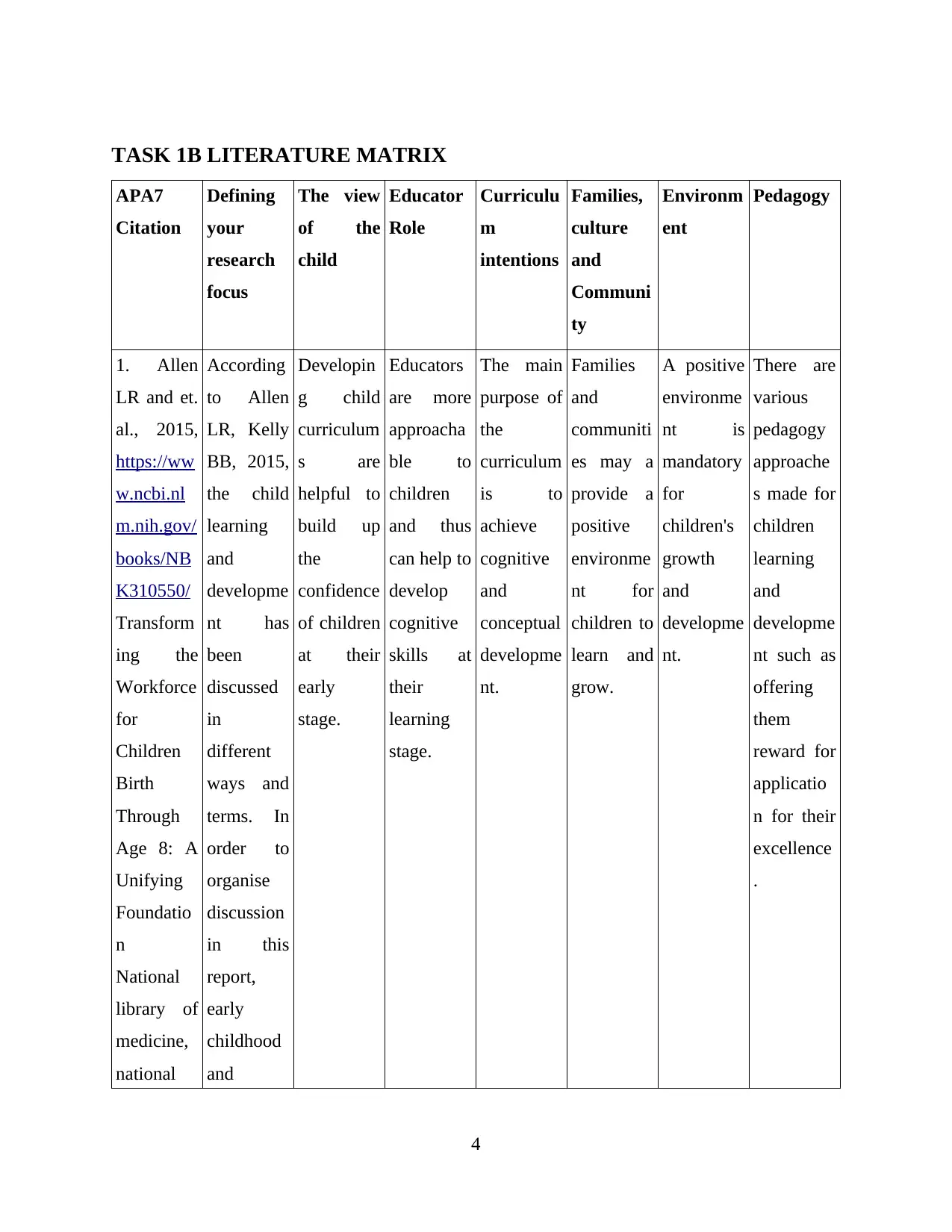
TASK 1B LITERATURE MATRIX
APA7
Citation
Defining
your
research
focus
The view
of the
child
Educator
Role
Curriculu
m
intentions
Families,
culture
and
Communi
ty
Environm
ent
Pedagogy
1. Allen
LR and et.
al., 2015,
https://ww
w.ncbi.nl
m.nih.gov/
books/NB
K310550/
Transform
ing the
Workforce
for
Children
Birth
Through
Age 8: A
Unifying
Foundatio
n
National
library of
medicine,
national
According
to Allen
LR, Kelly
BB, 2015,
the child
learning
and
developme
nt has
been
discussed
in
different
ways and
terms. In
order to
organise
discussion
in this
report,
early
childhood
and
Developin
g child
curriculum
s are
helpful to
build up
the
confidence
of children
at their
early
stage.
Educators
are more
approacha
ble to
children
and thus
can help to
develop
cognitive
skills at
their
learning
stage.
The main
purpose of
the
curriculum
is to
achieve
cognitive
and
conceptual
developme
nt.
Families
and
communiti
es may a
provide a
positive
environme
nt for
children to
learn and
grow.
A positive
environme
nt is
mandatory
for
children's
growth
and
developme
nt.
There are
various
pedagogy
approache
s made for
children
learning
and
developme
nt such as
offering
them
reward for
applicatio
n for their
excellence
.
4
APA7
Citation
Defining
your
research
focus
The view
of the
child
Educator
Role
Curriculu
m
intentions
Families,
culture
and
Communi
ty
Environm
ent
Pedagogy
1. Allen
LR and et.
al., 2015,
https://ww
w.ncbi.nl
m.nih.gov/
books/NB
K310550/
Transform
ing the
Workforce
for
Children
Birth
Through
Age 8: A
Unifying
Foundatio
n
National
library of
medicine,
national
According
to Allen
LR, Kelly
BB, 2015,
the child
learning
and
developme
nt has
been
discussed
in
different
ways and
terms. In
order to
organise
discussion
in this
report,
early
childhood
and
Developin
g child
curriculum
s are
helpful to
build up
the
confidence
of children
at their
early
stage.
Educators
are more
approacha
ble to
children
and thus
can help to
develop
cognitive
skills at
their
learning
stage.
The main
purpose of
the
curriculum
is to
achieve
cognitive
and
conceptual
developme
nt.
Families
and
communiti
es may a
provide a
positive
environme
nt for
children to
learn and
grow.
A positive
environme
nt is
mandatory
for
children's
growth
and
developme
nt.
There are
various
pedagogy
approache
s made for
children
learning
and
developme
nt such as
offering
them
reward for
applicatio
n for their
excellence
.
4
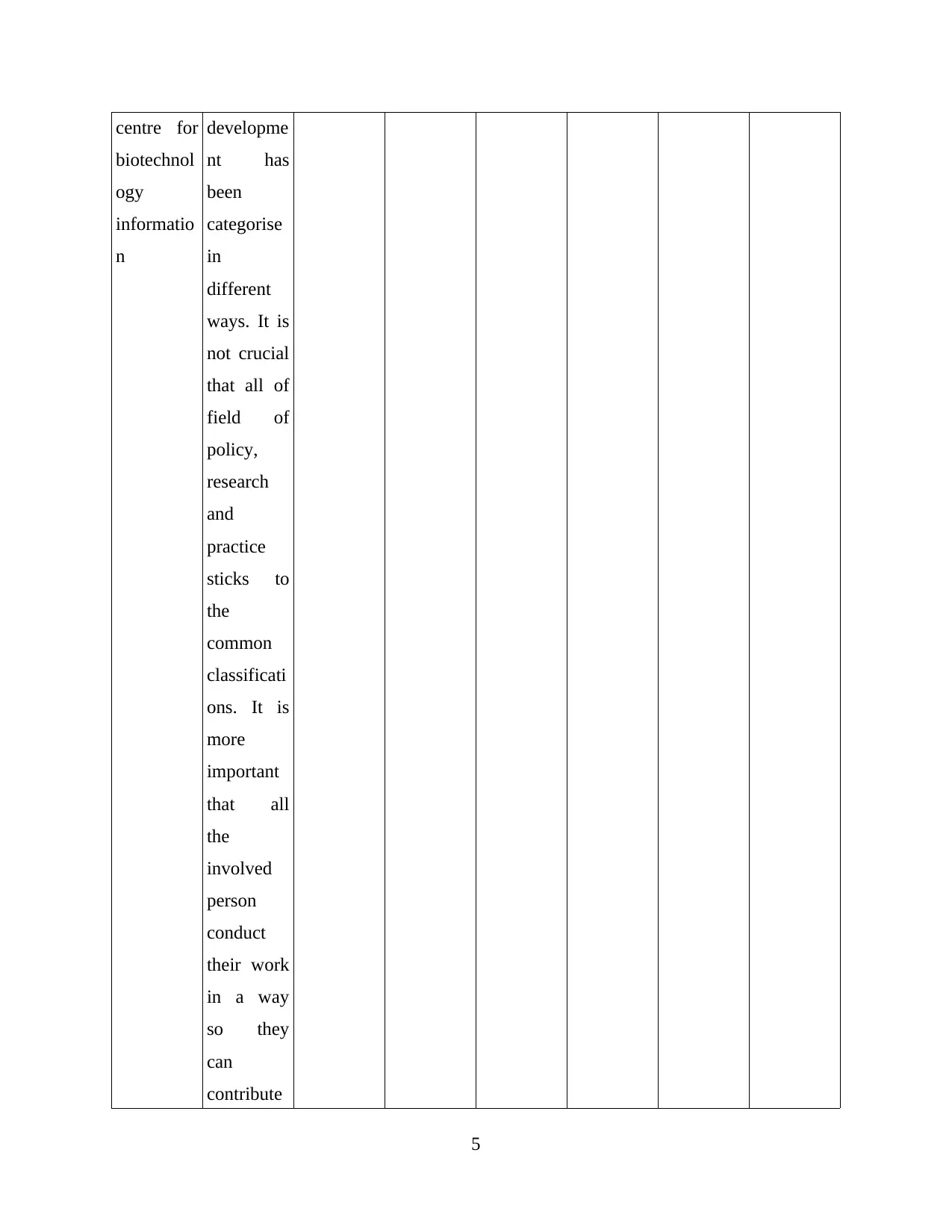
centre for
biotechnol
ogy
informatio
n
developme
nt has
been
categorise
in
different
ways. It is
not crucial
that all of
field of
policy,
research
and
practice
sticks to
the
common
classificati
ons. It is
more
important
that all
the
involved
person
conduct
their work
in a way
so they
can
contribute
5
biotechnol
ogy
informatio
n
developme
nt has
been
categorise
in
different
ways. It is
not crucial
that all of
field of
policy,
research
and
practice
sticks to
the
common
classificati
ons. It is
more
important
that all
the
involved
person
conduct
their work
in a way
so they
can
contribute
5
Paraphrase This Document
Need a fresh take? Get an instant paraphrase of this document with our AI Paraphraser
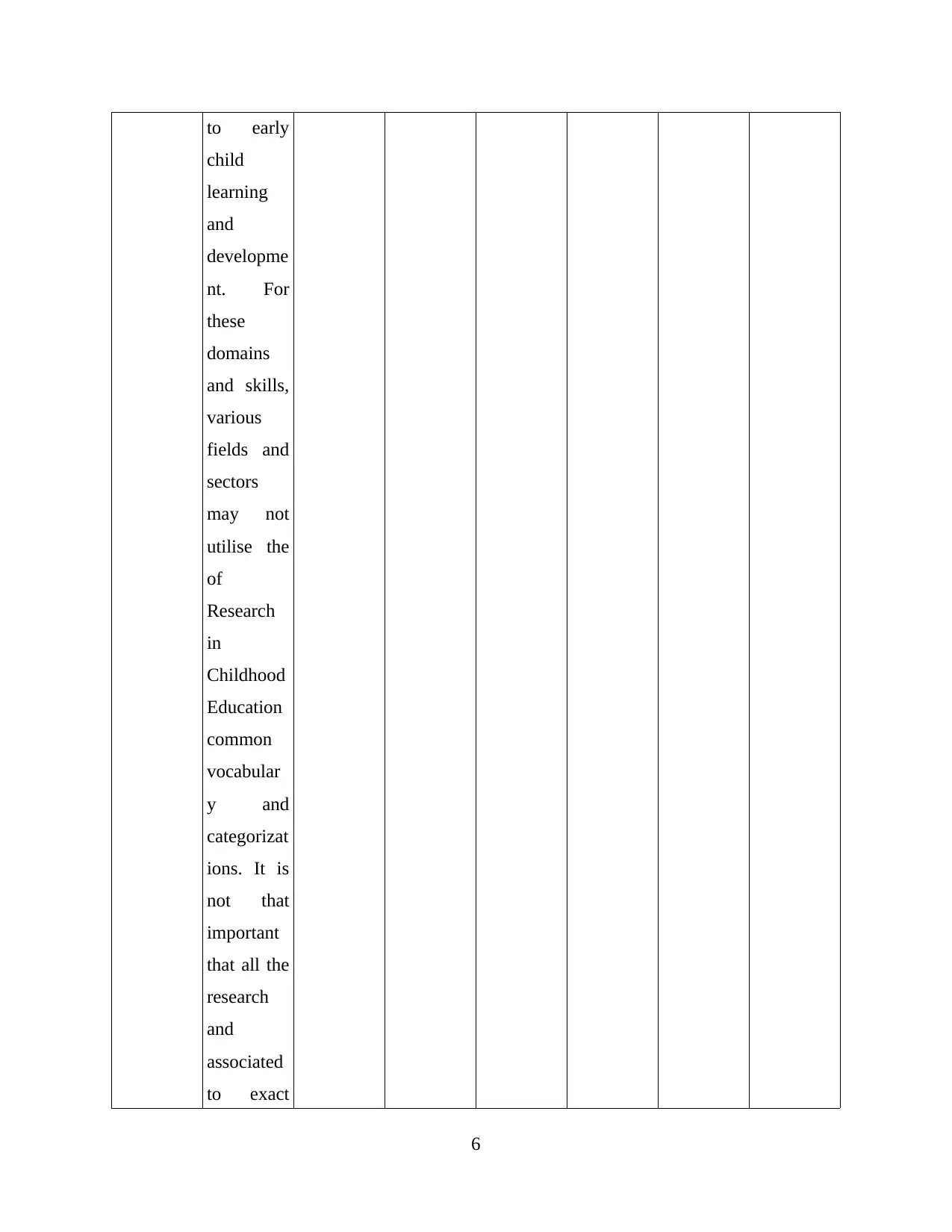
to early
child
learning
and
developme
nt. For
these
domains
and skills,
various
fields and
sectors
may not
utilise the
of
Research
in
Childhood
Education
common
vocabular
y and
categorizat
ions. It is
not that
important
that all the
research
and
associated
to exact
6
child
learning
and
developme
nt. For
these
domains
and skills,
various
fields and
sectors
may not
utilise the
of
Research
in
Childhood
Education
common
vocabular
y and
categorizat
ions. It is
not that
important
that all the
research
and
associated
to exact
6
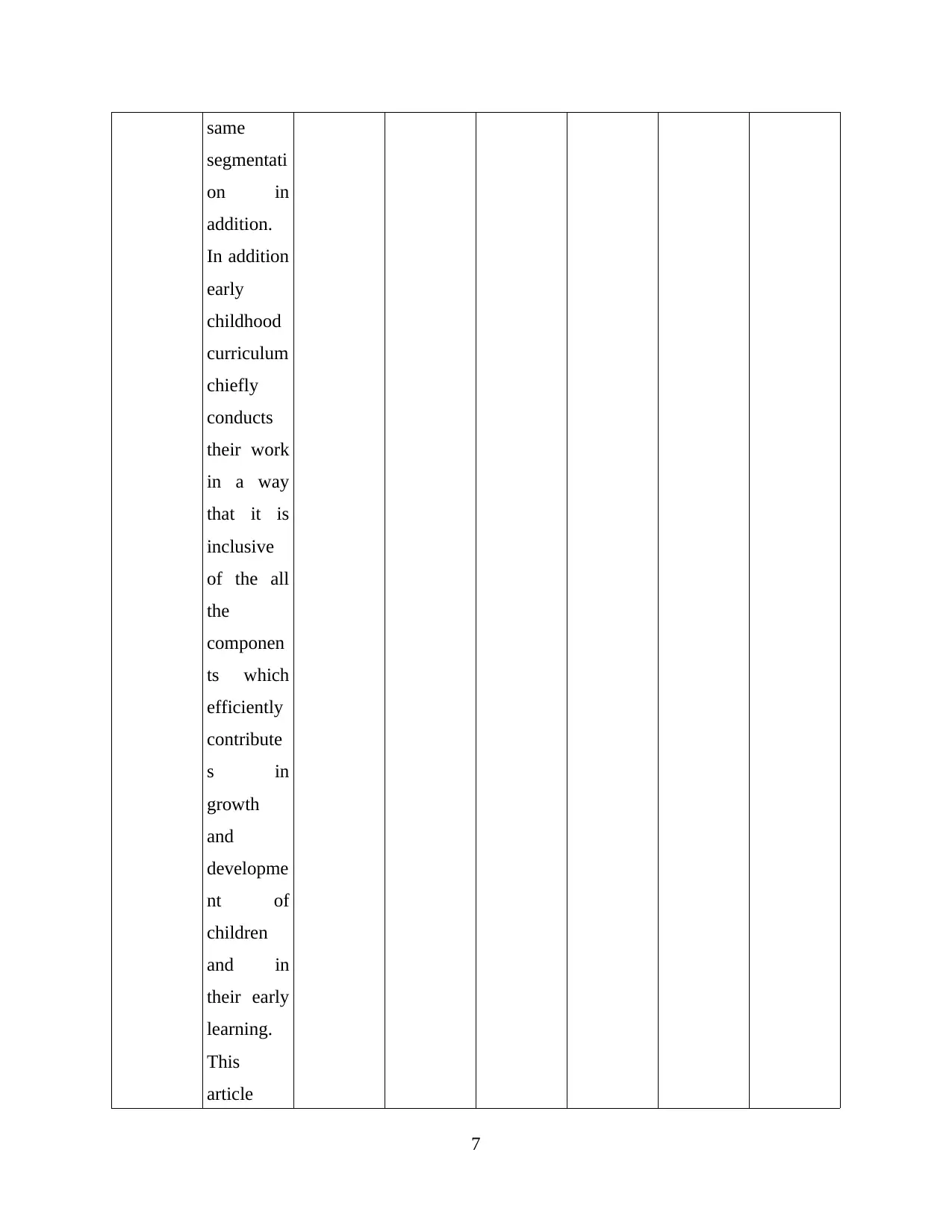
same
segmentati
on in
addition.
In addition
early
childhood
curriculum
chiefly
conducts
their work
in a way
that it is
inclusive
of the all
the
componen
ts which
efficiently
contribute
s in
growth
and
developme
nt of
children
and in
their early
learning.
This
article
7
segmentati
on in
addition.
In addition
early
childhood
curriculum
chiefly
conducts
their work
in a way
that it is
inclusive
of the all
the
componen
ts which
efficiently
contribute
s in
growth
and
developme
nt of
children
and in
their early
learning.
This
article
7
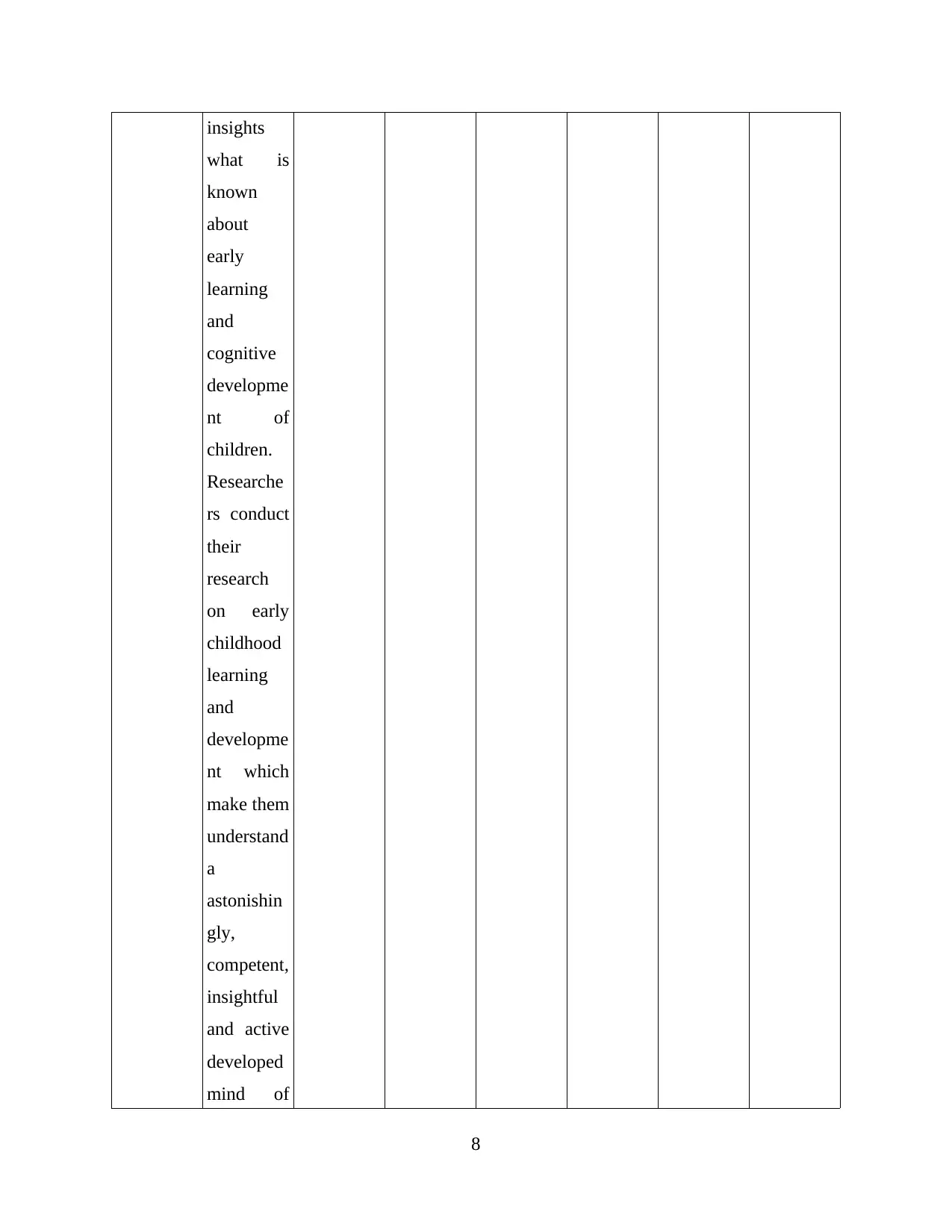
insights
what is
known
about
early
learning
and
cognitive
developme
nt of
children.
Researche
rs conduct
their
research
on early
childhood
learning
and
developme
nt which
make them
understand
a
astonishin
gly,
competent,
insightful
and active
developed
mind of
8
what is
known
about
early
learning
and
cognitive
developme
nt of
children.
Researche
rs conduct
their
research
on early
childhood
learning
and
developme
nt which
make them
understand
a
astonishin
gly,
competent,
insightful
and active
developed
mind of
8
Secure Best Marks with AI Grader
Need help grading? Try our AI Grader for instant feedback on your assignments.
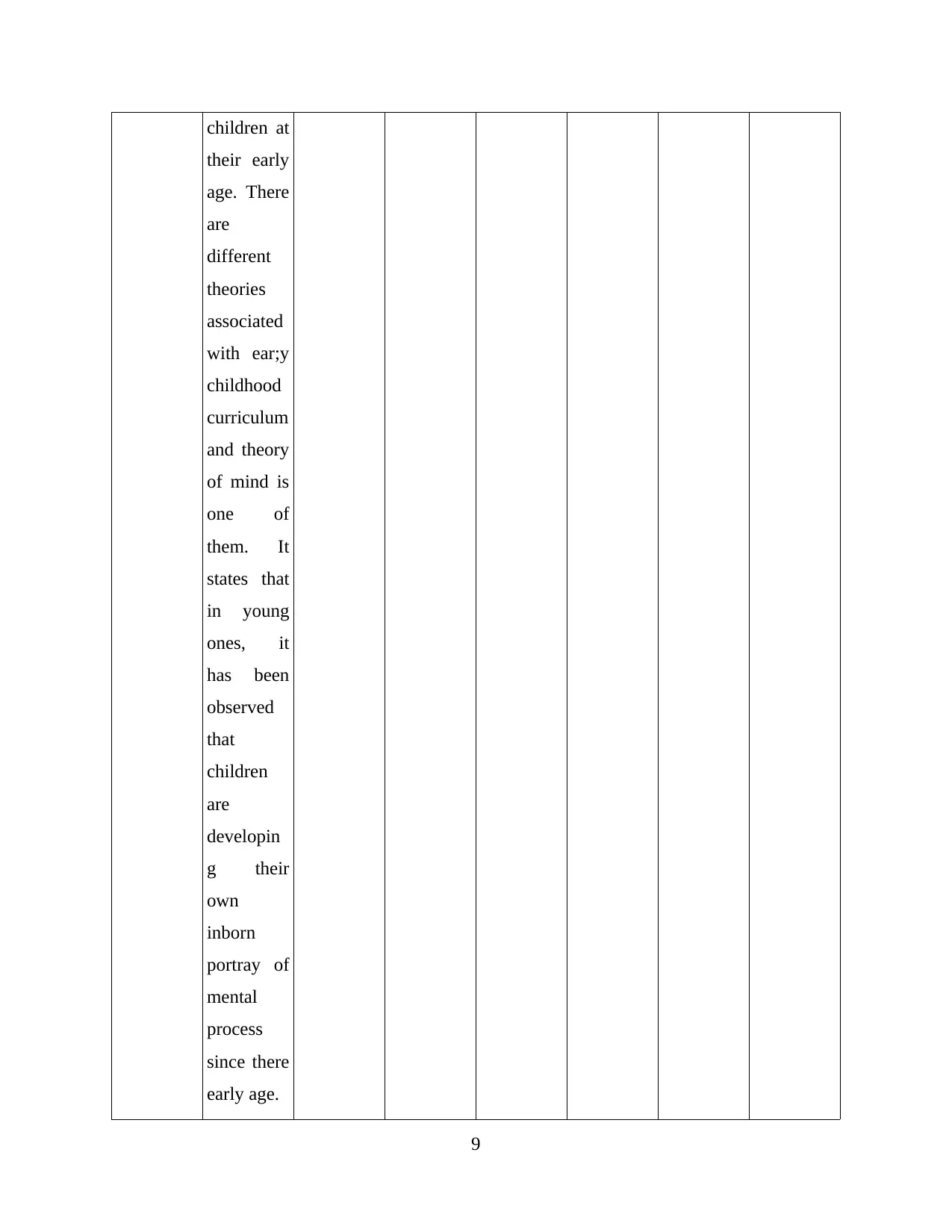
children at
their early
age. There
are
different
theories
associated
with ear;y
childhood
curriculum
and theory
of mind is
one of
them. It
states that
in young
ones, it
has been
observed
that
children
are
developin
g their
own
inborn
portray of
mental
process
since there
early age.
9
their early
age. There
are
different
theories
associated
with ear;y
childhood
curriculum
and theory
of mind is
one of
them. It
states that
in young
ones, it
has been
observed
that
children
are
developin
g their
own
inborn
portray of
mental
process
since there
early age.
9
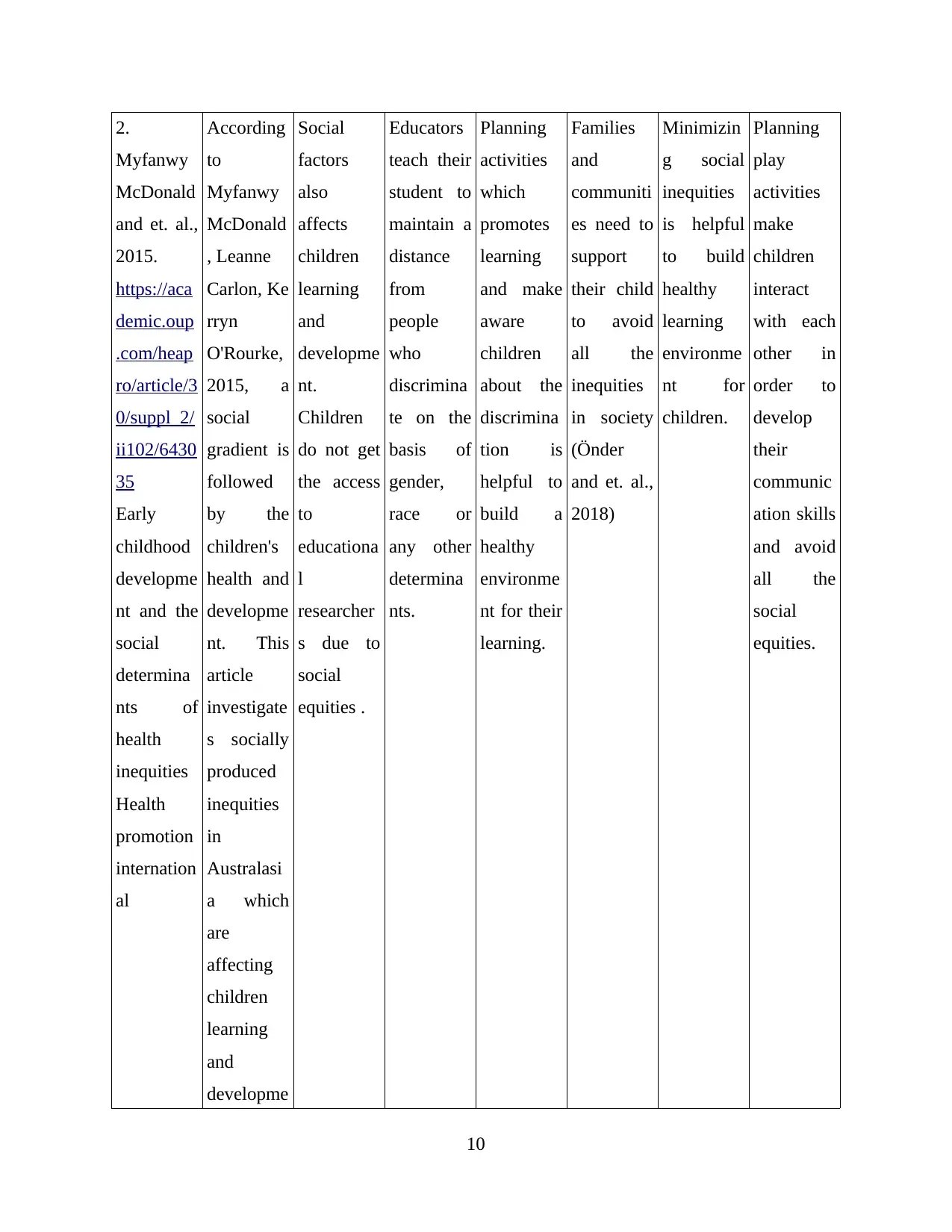
2.
Myfanwy
McDonald
and et. al.,
2015.
https://aca
demic.oup
.com/heap
ro/article/3
0/suppl_2/
ii102/6430
35
Early
childhood
developme
nt and the
social
determina
nts of
health
inequities
Health
promotion
internation
al
According
to
Myfanwy
McDonald
, Leanne
Carlon, Ke
rryn
O'Rourke,
2015, a
social
gradient is
followed
by the
children's
health and
developme
nt. This
article
investigate
s socially
produced
inequities
in
Australasi
a which
are
affecting
children
learning
and
developme
Social
factors
also
affects
children
learning
and
developme
nt.
Children
do not get
the access
to
educationa
l
researcher
s due to
social
equities .
Educators
teach their
student to
maintain a
distance
from
people
who
discrimina
te on the
basis of
gender,
race or
any other
determina
nts.
Planning
activities
which
promotes
learning
and make
aware
children
about the
discrimina
tion is
helpful to
build a
healthy
environme
nt for their
learning.
Families
and
communiti
es need to
support
their child
to avoid
all the
inequities
in society
(Önder
and et. al.,
2018)
Minimizin
g social
inequities
is helpful
to build
healthy
learning
environme
nt for
children.
Planning
play
activities
make
children
interact
with each
other in
order to
develop
their
communic
ation skills
and avoid
all the
social
equities.
10
Myfanwy
McDonald
and et. al.,
2015.
https://aca
demic.oup
.com/heap
ro/article/3
0/suppl_2/
ii102/6430
35
Early
childhood
developme
nt and the
social
determina
nts of
health
inequities
Health
promotion
internation
al
According
to
Myfanwy
McDonald
, Leanne
Carlon, Ke
rryn
O'Rourke,
2015, a
social
gradient is
followed
by the
children's
health and
developme
nt. This
article
investigate
s socially
produced
inequities
in
Australasi
a which
are
affecting
children
learning
and
developme
Social
factors
also
affects
children
learning
and
developme
nt.
Children
do not get
the access
to
educationa
l
researcher
s due to
social
equities .
Educators
teach their
student to
maintain a
distance
from
people
who
discrimina
te on the
basis of
gender,
race or
any other
determina
nts.
Planning
activities
which
promotes
learning
and make
aware
children
about the
discrimina
tion is
helpful to
build a
healthy
environme
nt for their
learning.
Families
and
communiti
es need to
support
their child
to avoid
all the
inequities
in society
(Önder
and et. al.,
2018)
Minimizin
g social
inequities
is helpful
to build
healthy
learning
environme
nt for
children.
Planning
play
activities
make
children
interact
with each
other in
order to
develop
their
communic
ation skills
and avoid
all the
social
equities.
10
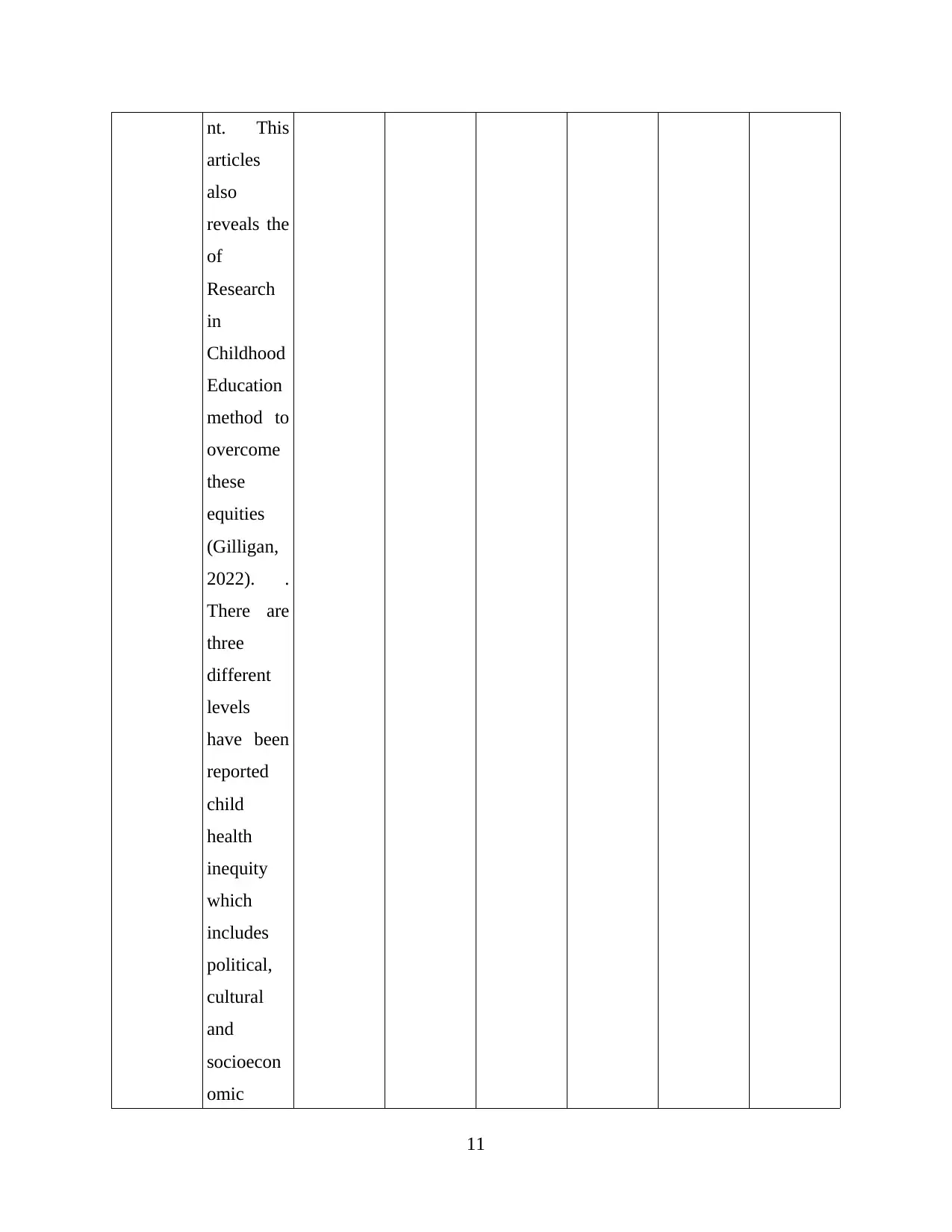
nt. This
articles
also
reveals the
of
Research
in
Childhood
Education
method to
overcome
these
equities
(Gilligan,
2022). .
There are
three
different
levels
have been
reported
child
health
inequity
which
includes
political,
cultural
and
socioecon
omic
11
articles
also
reveals the
of
Research
in
Childhood
Education
method to
overcome
these
equities
(Gilligan,
2022). .
There are
three
different
levels
have been
reported
child
health
inequity
which
includes
political,
cultural
and
socioecon
omic
11
Paraphrase This Document
Need a fresh take? Get an instant paraphrase of this document with our AI Paraphraser
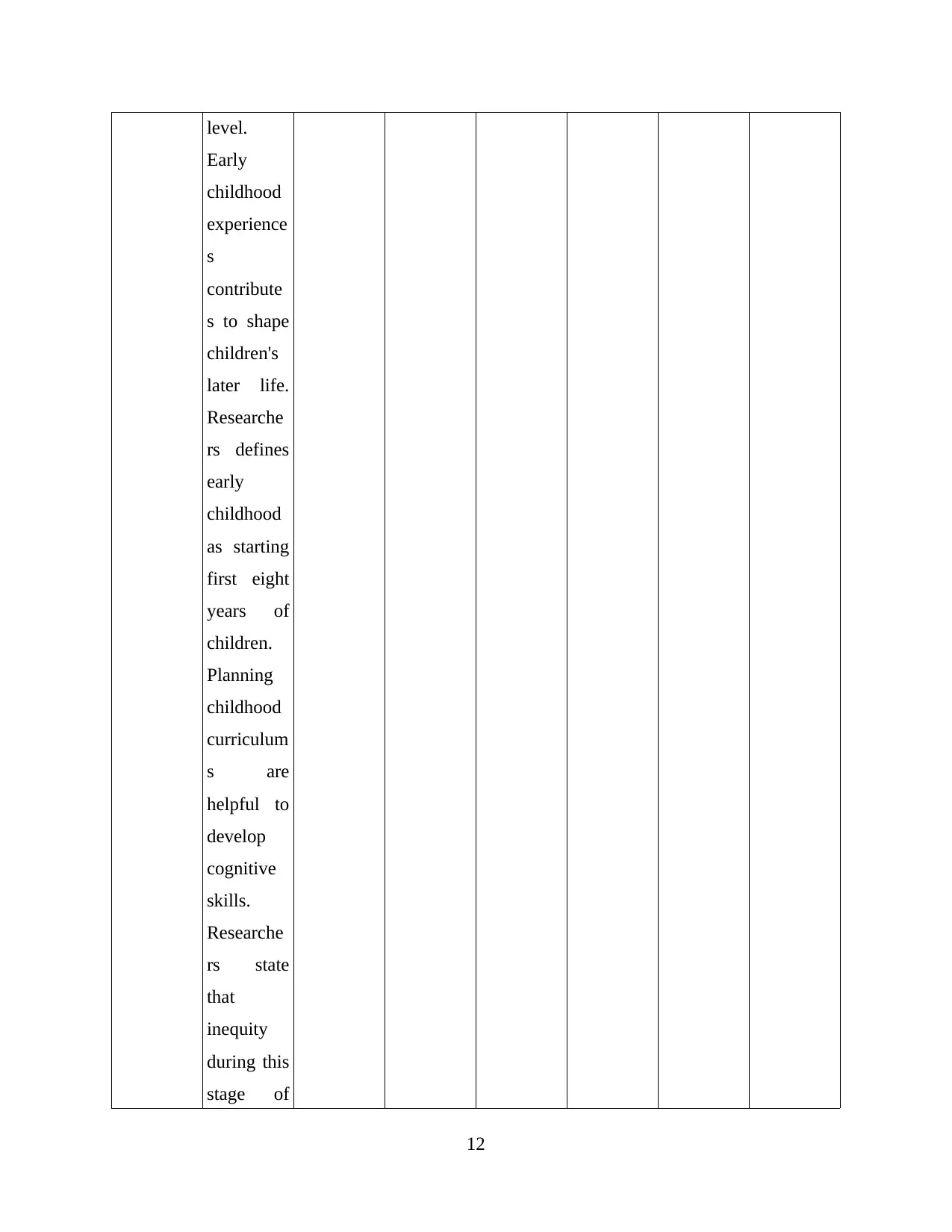
level.
Early
childhood
experience
s
contribute
s to shape
children's
later life.
Researche
rs defines
early
childhood
as starting
first eight
years of
children.
Planning
childhood
curriculum
s are
helpful to
develop
cognitive
skills.
Researche
rs state
that
inequity
during this
stage of
12
Early
childhood
experience
s
contribute
s to shape
children's
later life.
Researche
rs defines
early
childhood
as starting
first eight
years of
children.
Planning
childhood
curriculum
s are
helpful to
develop
cognitive
skills.
Researche
rs state
that
inequity
during this
stage of
12
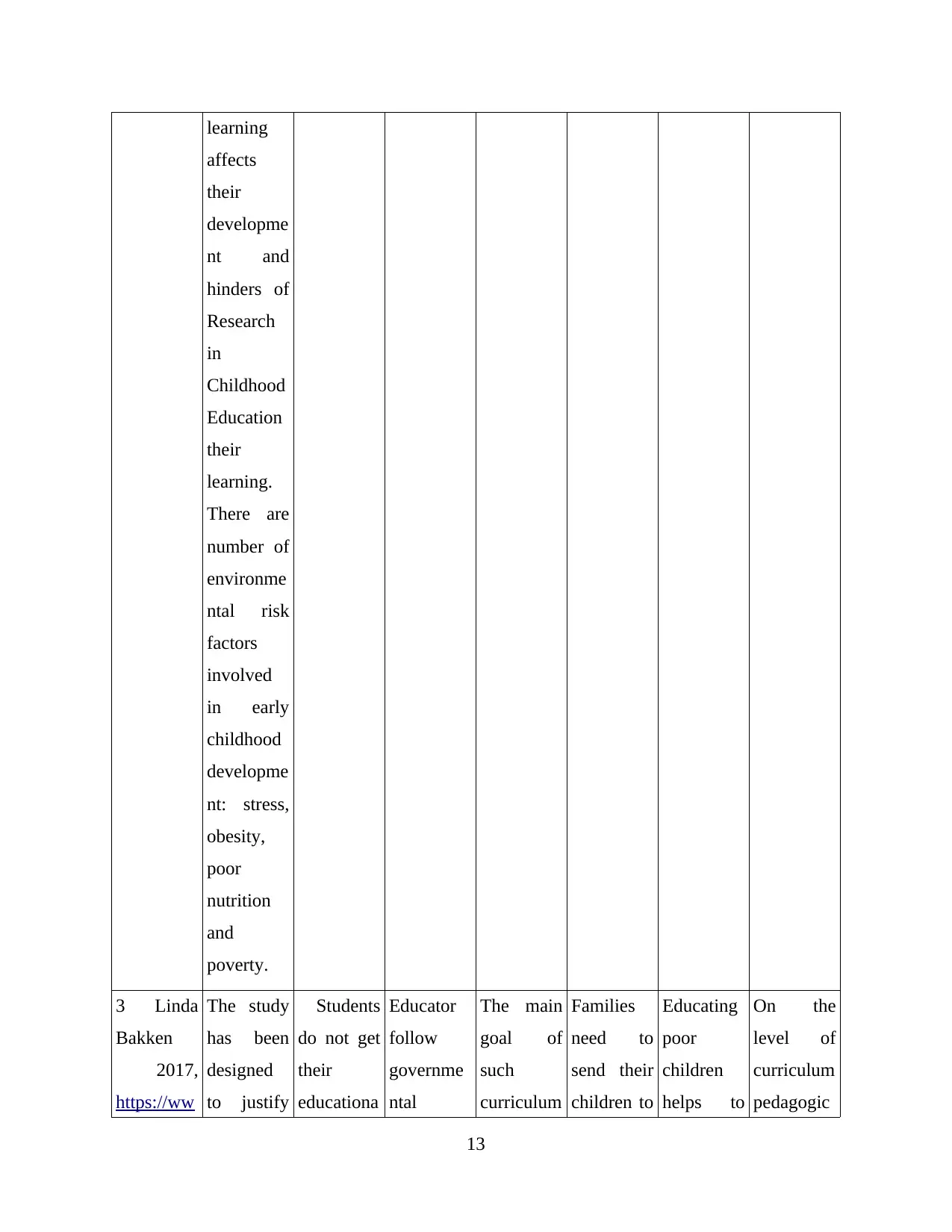
learning
affects
their
developme
nt and
hinders of
Research
in
Childhood
Education
their
learning.
There are
number of
environme
ntal risk
factors
involved
in early
childhood
developme
nt: stress,
obesity,
poor
nutrition
and
poverty.
3 Linda
Bakken
2017,
https://ww
The study
has been
designed
to justify
Students
do not get
their
educationa
Educator
follow
governme
ntal
The main
goal of
such
curriculum
Families
need to
send their
children to
Educating
poor
children
helps to
On the
level of
curriculum
pedagogic
13
affects
their
developme
nt and
hinders of
Research
in
Childhood
Education
their
learning.
There are
number of
environme
ntal risk
factors
involved
in early
childhood
developme
nt: stress,
obesity,
poor
nutrition
and
poverty.
3 Linda
Bakken
2017,
https://ww
The study
has been
designed
to justify
Students
do not get
their
educationa
Educator
follow
governme
ntal
The main
goal of
such
curriculum
Families
need to
send their
children to
Educating
poor
children
helps to
On the
level of
curriculum
pedagogic
13
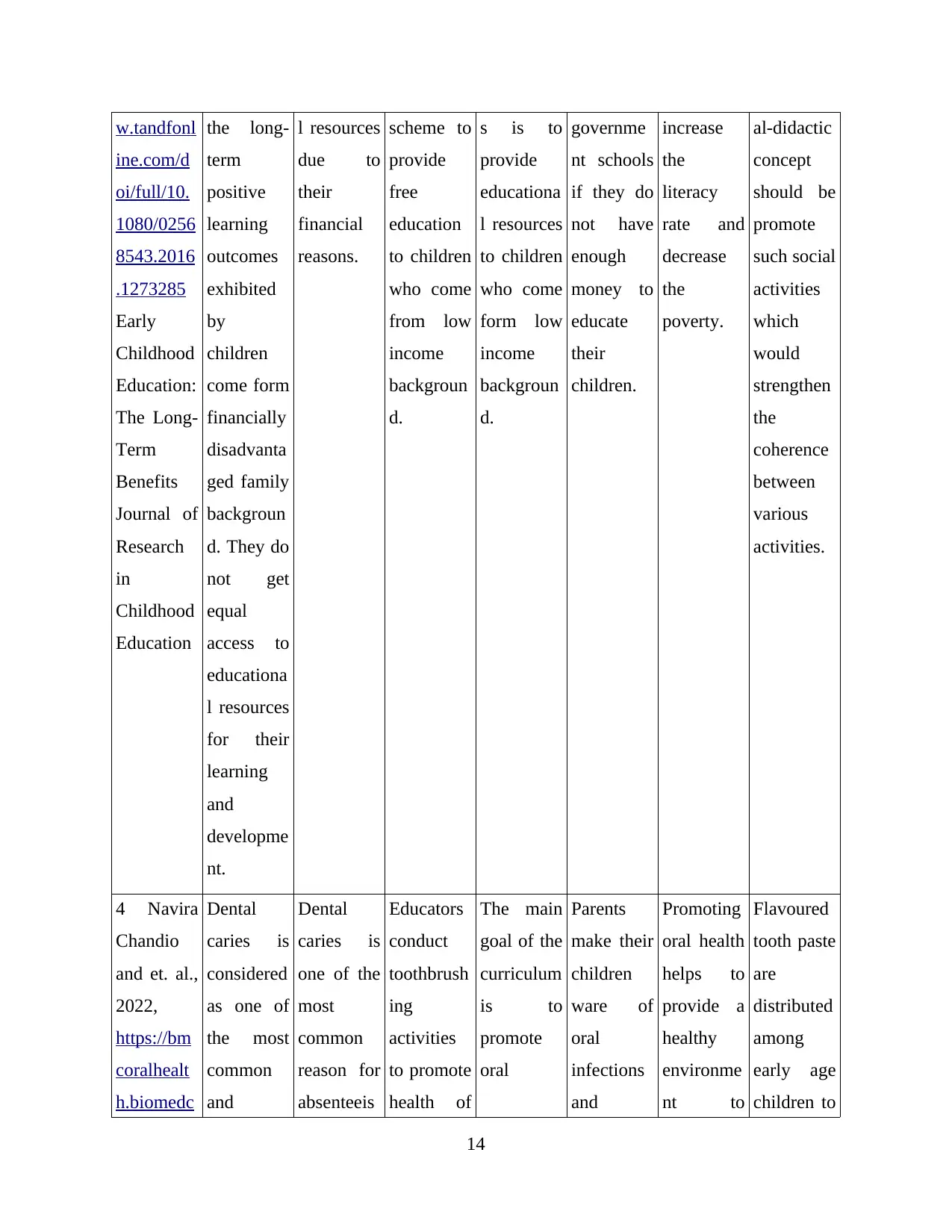
w.tandfonl
ine.com/d
oi/full/10.
1080/0256
8543.2016
.1273285
Early
Childhood
Education:
The Long-
Term
Benefits
Journal of
Research
in
Childhood
Education
the long-
term
positive
learning
outcomes
exhibited
by
children
come form
financially
disadvanta
ged family
backgroun
d. They do
not get
equal
access to
educationa
l resources
for their
learning
and
developme
nt.
l resources
due to
their
financial
reasons.
scheme to
provide
free
education
to children
who come
from low
income
backgroun
d.
s is to
provide
educationa
l resources
to children
who come
form low
income
backgroun
d.
governme
nt schools
if they do
not have
enough
money to
educate
their
children.
increase
the
literacy
rate and
decrease
the
poverty.
al-didactic
concept
should be
promote
such social
activities
which
would
strengthen
the
coherence
between
various
activities.
4 Navira
Chandio
and et. al.,
2022,
https://bm
coralhealt
h.biomedc
Dental
caries is
considered
as one of
the most
common
and
Dental
caries is
one of the
most
common
reason for
absenteeis
Educators
conduct
toothbrush
ing
activities
to promote
health of
The main
goal of the
curriculum
is to
promote
oral
Parents
make their
children
ware of
oral
infections
and
Promoting
oral health
helps to
provide a
healthy
environme
nt to
Flavoured
tooth paste
are
distributed
among
early age
children to
14
ine.com/d
oi/full/10.
1080/0256
8543.2016
.1273285
Early
Childhood
Education:
The Long-
Term
Benefits
Journal of
Research
in
Childhood
Education
the long-
term
positive
learning
outcomes
exhibited
by
children
come form
financially
disadvanta
ged family
backgroun
d. They do
not get
equal
access to
educationa
l resources
for their
learning
and
developme
nt.
l resources
due to
their
financial
reasons.
scheme to
provide
free
education
to children
who come
from low
income
backgroun
d.
s is to
provide
educationa
l resources
to children
who come
form low
income
backgroun
d.
governme
nt schools
if they do
not have
enough
money to
educate
their
children.
increase
the
literacy
rate and
decrease
the
poverty.
al-didactic
concept
should be
promote
such social
activities
which
would
strengthen
the
coherence
between
various
activities.
4 Navira
Chandio
and et. al.,
2022,
https://bm
coralhealt
h.biomedc
Dental
caries is
considered
as one of
the most
common
and
Dental
caries is
one of the
most
common
reason for
absenteeis
Educators
conduct
toothbrush
ing
activities
to promote
health of
The main
goal of the
curriculum
is to
promote
oral
Parents
make their
children
ware of
oral
infections
and
Promoting
oral health
helps to
provide a
healthy
environme
nt to
Flavoured
tooth paste
are
distributed
among
early age
children to
14
Secure Best Marks with AI Grader
Need help grading? Try our AI Grader for instant feedback on your assignments.
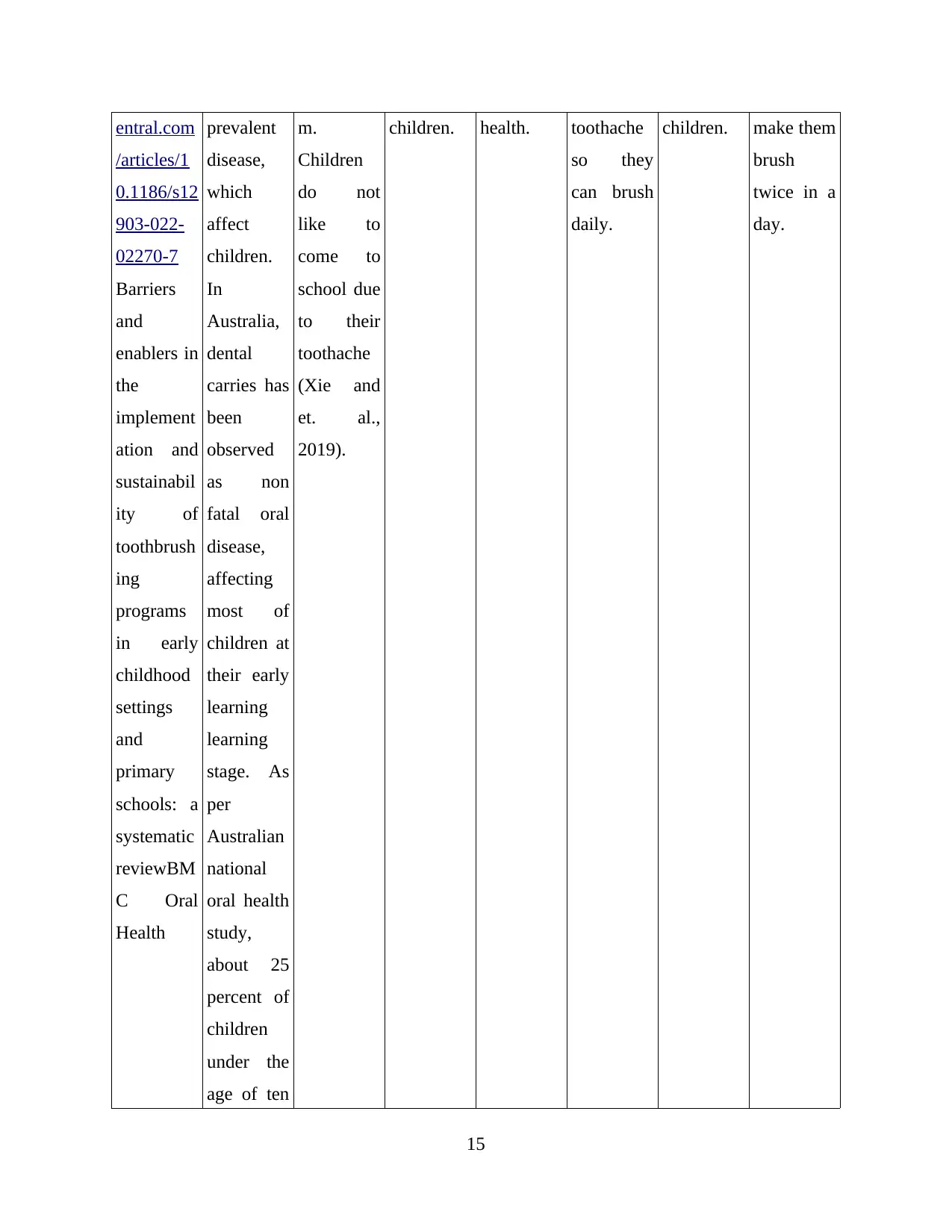
entral.com
/articles/1
0.1186/s12
903-022-
02270-7
Barriers
and
enablers in
the
implement
ation and
sustainabil
ity of
toothbrush
ing
programs
in early
childhood
settings
and
primary
schools: a
systematic
reviewBM
C Oral
Health
prevalent
disease,
which
affect
children.
In
Australia,
dental
carries has
been
observed
as non
fatal oral
disease,
affecting
most of
children at
their early
learning
learning
stage. As
per
Australian
national
oral health
study,
about 25
percent of
children
under the
age of ten
m.
Children
do not
like to
come to
school due
to their
toothache
(Xie and
et. al.,
2019).
children. health. toothache
so they
can brush
daily.
children. make them
brush
twice in a
day.
15
/articles/1
0.1186/s12
903-022-
02270-7
Barriers
and
enablers in
the
implement
ation and
sustainabil
ity of
toothbrush
ing
programs
in early
childhood
settings
and
primary
schools: a
systematic
reviewBM
C Oral
Health
prevalent
disease,
which
affect
children.
In
Australia,
dental
carries has
been
observed
as non
fatal oral
disease,
affecting
most of
children at
their early
learning
learning
stage. As
per
Australian
national
oral health
study,
about 25
percent of
children
under the
age of ten
m.
Children
do not
like to
come to
school due
to their
toothache
(Xie and
et. al.,
2019).
children. health. toothache
so they
can brush
daily.
children. make them
brush
twice in a
day.
15
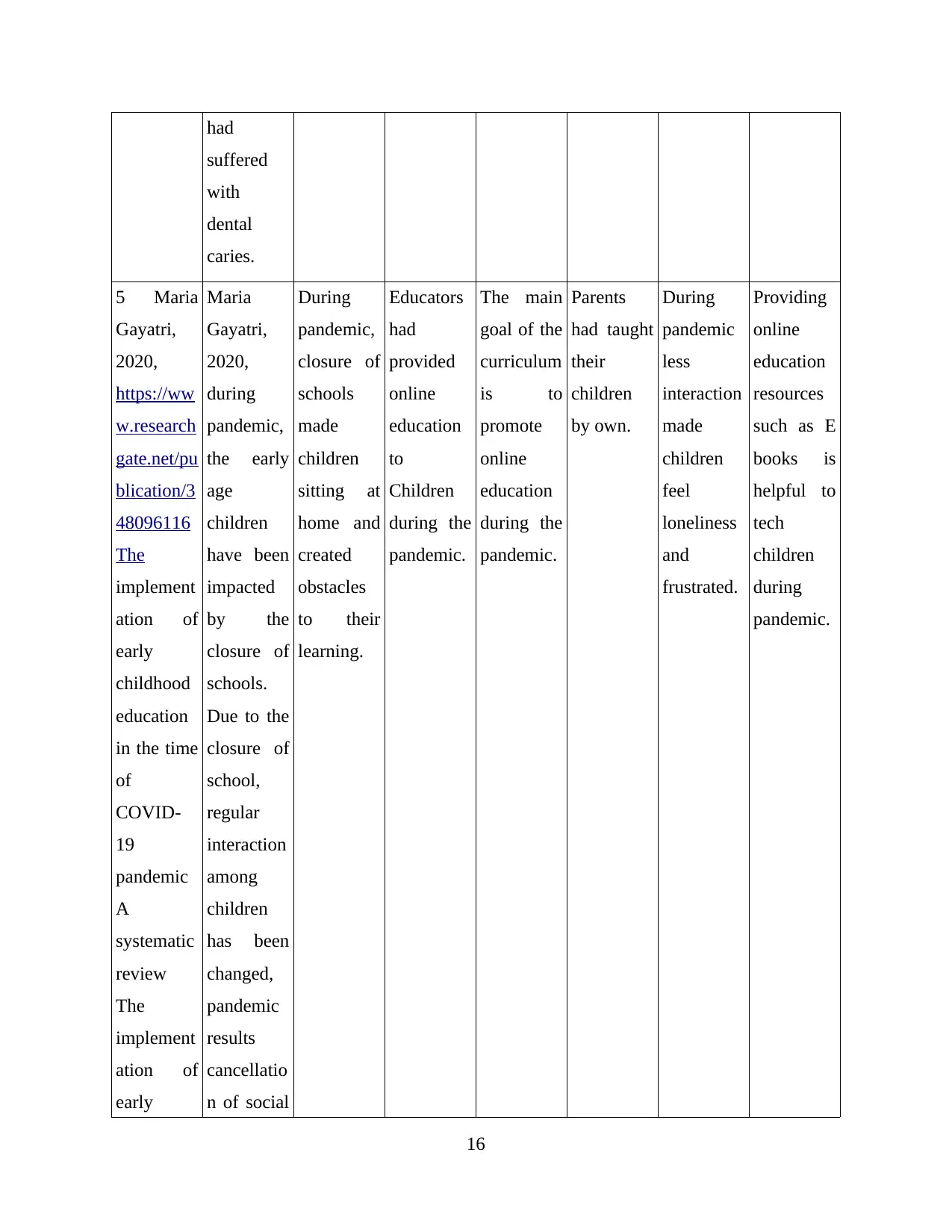
had
suffered
with
dental
caries.
5 Maria
Gayatri,
2020,
https://ww
w.research
gate.net/pu
blication/3
48096116
The
implement
ation of
early
childhood
education
in the time
of
COVID-
19
pandemic
A
systematic
review
The
implement
ation of
early
Maria
Gayatri,
2020,
during
pandemic,
the early
age
children
have been
impacted
by the
closure of
schools.
Due to the
closure of
school,
regular
interaction
among
children
has been
changed,
pandemic
results
cancellatio
n of social
During
pandemic,
closure of
schools
made
children
sitting at
home and
created
obstacles
to their
learning.
Educators
had
provided
online
education
to
Children
during the
pandemic.
The main
goal of the
curriculum
is to
promote
online
education
during the
pandemic.
Parents
had taught
their
children
by own.
During
pandemic
less
interaction
made
children
feel
loneliness
and
frustrated.
Providing
online
education
resources
such as E
books is
helpful to
tech
children
during
pandemic.
16
suffered
with
dental
caries.
5 Maria
Gayatri,
2020,
https://ww
w.research
gate.net/pu
blication/3
48096116
The
implement
ation of
early
childhood
education
in the time
of
COVID-
19
pandemic
A
systematic
review
The
implement
ation of
early
Maria
Gayatri,
2020,
during
pandemic,
the early
age
children
have been
impacted
by the
closure of
schools.
Due to the
closure of
school,
regular
interaction
among
children
has been
changed,
pandemic
results
cancellatio
n of social
During
pandemic,
closure of
schools
made
children
sitting at
home and
created
obstacles
to their
learning.
Educators
had
provided
online
education
to
Children
during the
pandemic.
The main
goal of the
curriculum
is to
promote
online
education
during the
pandemic.
Parents
had taught
their
children
by own.
During
pandemic
less
interaction
made
children
feel
loneliness
and
frustrated.
Providing
online
education
resources
such as E
books is
helpful to
tech
children
during
pandemic.
16
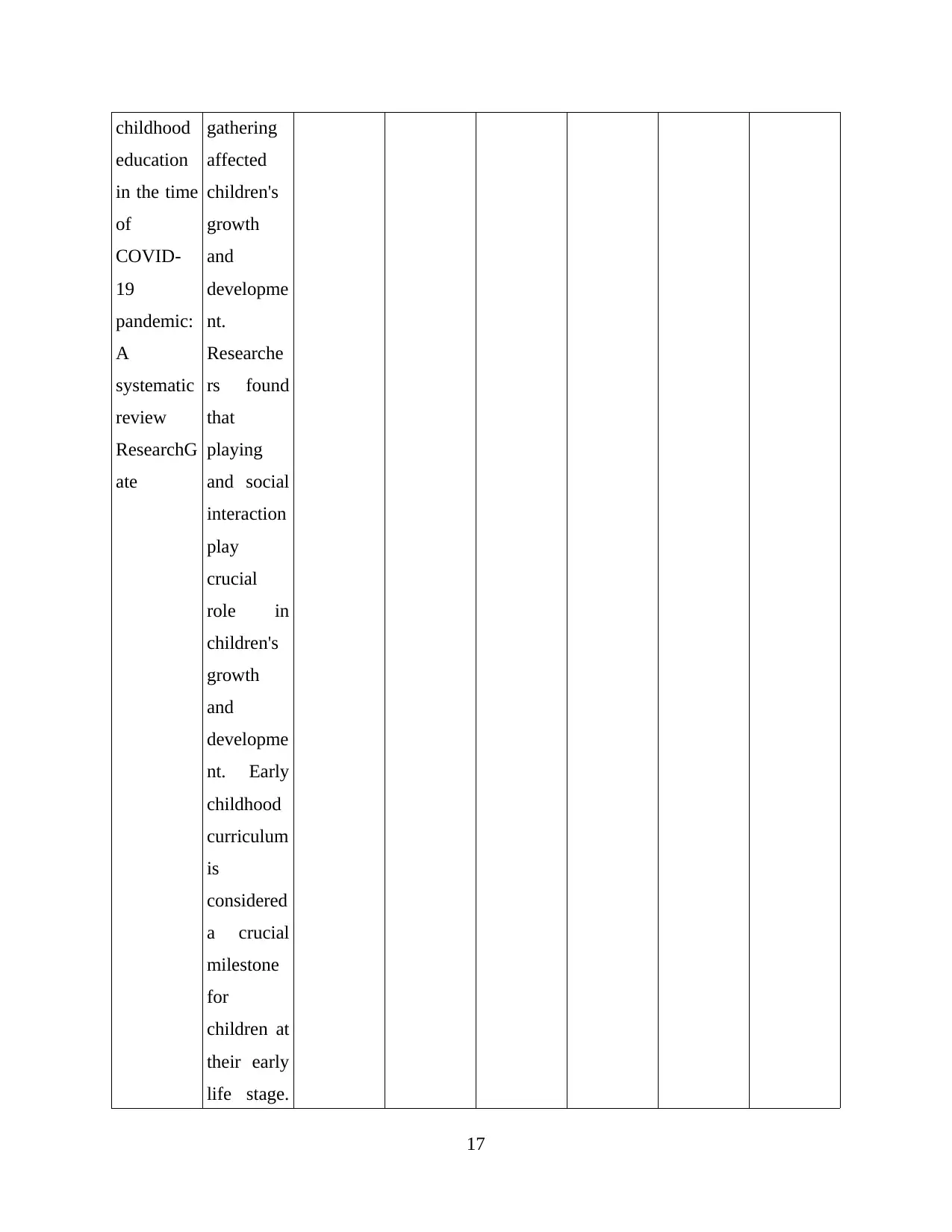
childhood
education
in the time
of
COVID-
19
pandemic:
A
systematic
review
ResearchG
ate
gathering
affected
children's
growth
and
developme
nt.
Researche
rs found
that
playing
and social
interaction
play
crucial
role in
children's
growth
and
developme
nt. Early
childhood
curriculum
is
considered
a crucial
milestone
for
children at
their early
life stage.
17
education
in the time
of
COVID-
19
pandemic:
A
systematic
review
ResearchG
ate
gathering
affected
children's
growth
and
developme
nt.
Researche
rs found
that
playing
and social
interaction
play
crucial
role in
children's
growth
and
developme
nt. Early
childhood
curriculum
is
considered
a crucial
milestone
for
children at
their early
life stage.
17
Paraphrase This Document
Need a fresh take? Get an instant paraphrase of this document with our AI Paraphraser
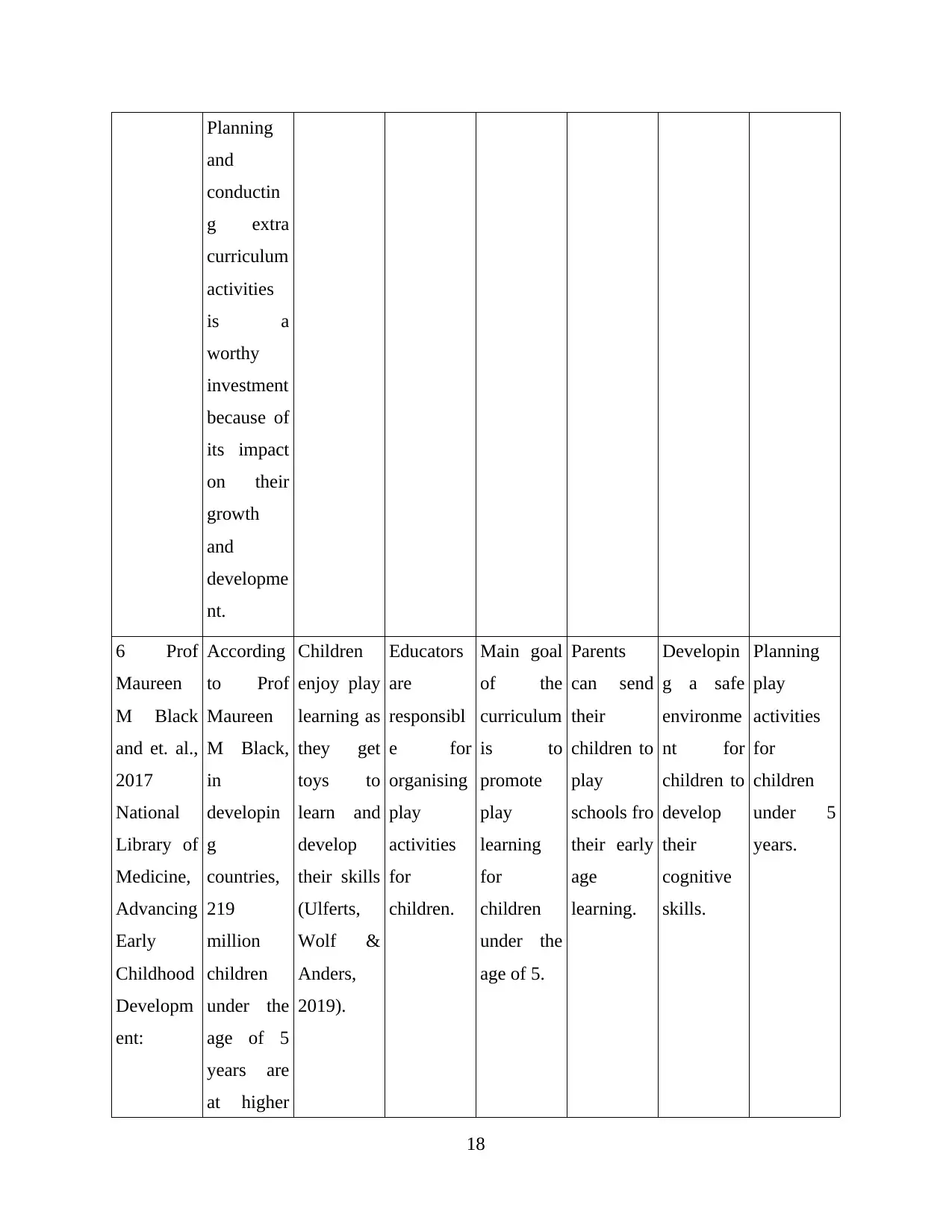
Planning
and
conductin
g extra
curriculum
activities
is a
worthy
investment
because of
its impact
on their
growth
and
developme
nt.
6 Prof
Maureen
M Black
and et. al.,
2017
National
Library of
Medicine,
Advancing
Early
Childhood
Developm
ent:
According
to Prof
Maureen
M Black,
in
developin
g
countries,
219
million
children
under the
age of 5
years are
at higher
Children
enjoy play
learning as
they get
toys to
learn and
develop
their skills
(Ulferts,
Wolf &
Anders,
2019).
Educators
are
responsibl
e for
organising
play
activities
for
children.
Main goal
of the
curriculum
is to
promote
play
learning
for
children
under the
age of 5.
Parents
can send
their
children to
play
schools fro
their early
age
learning.
Developin
g a safe
environme
nt for
children to
develop
their
cognitive
skills.
Planning
play
activities
for
children
under 5
years.
18
and
conductin
g extra
curriculum
activities
is a
worthy
investment
because of
its impact
on their
growth
and
developme
nt.
6 Prof
Maureen
M Black
and et. al.,
2017
National
Library of
Medicine,
Advancing
Early
Childhood
Developm
ent:
According
to Prof
Maureen
M Black,
in
developin
g
countries,
219
million
children
under the
age of 5
years are
at higher
Children
enjoy play
learning as
they get
toys to
learn and
develop
their skills
(Ulferts,
Wolf &
Anders,
2019).
Educators
are
responsibl
e for
organising
play
activities
for
children.
Main goal
of the
curriculum
is to
promote
play
learning
for
children
under the
age of 5.
Parents
can send
their
children to
play
schools fro
their early
age
learning.
Developin
g a safe
environme
nt for
children to
develop
their
cognitive
skills.
Planning
play
activities
for
children
under 5
years.
18
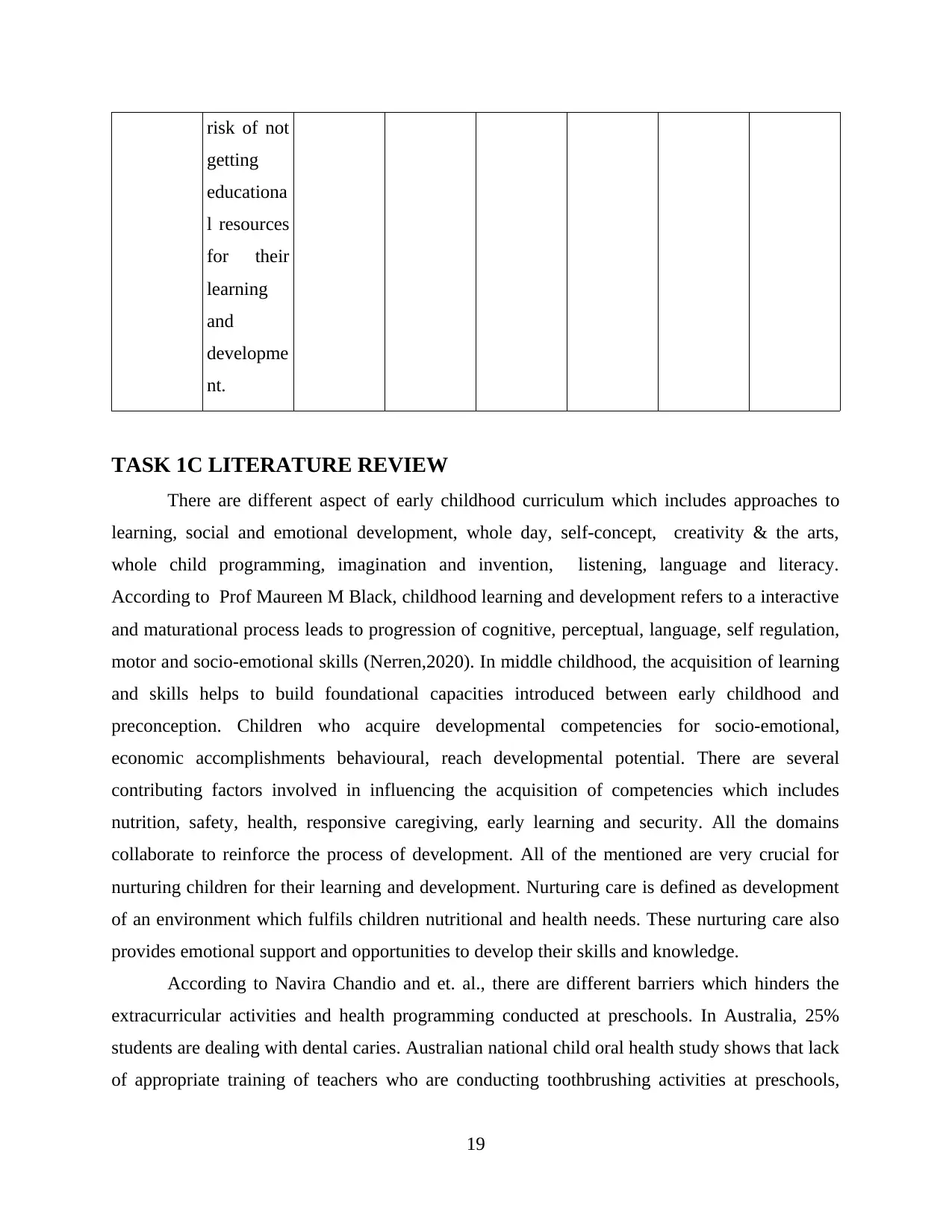
risk of not
getting
educationa
l resources
for their
learning
and
developme
nt.
TASK 1C LITERATURE REVIEW
There are different aspect of early childhood curriculum which includes approaches to
learning, social and emotional development, whole day, self-concept, creativity & the arts,
whole child programming, imagination and invention, listening, language and literacy.
According to Prof Maureen M Black, childhood learning and development refers to a interactive
and maturational process leads to progression of cognitive, perceptual, language, self regulation,
motor and socio-emotional skills (Nerren,2020). In middle childhood, the acquisition of learning
and skills helps to build foundational capacities introduced between early childhood and
preconception. Children who acquire developmental competencies for socio-emotional,
economic accomplishments behavioural, reach developmental potential. There are several
contributing factors involved in influencing the acquisition of competencies which includes
nutrition, safety, health, responsive caregiving, early learning and security. All the domains
collaborate to reinforce the process of development. All of the mentioned are very crucial for
nurturing children for their learning and development. Nurturing care is defined as development
of an environment which fulfils children nutritional and health needs. These nurturing care also
provides emotional support and opportunities to develop their skills and knowledge.
According to Navira Chandio and et. al., there are different barriers which hinders the
extracurricular activities and health programming conducted at preschools. In Australia, 25%
students are dealing with dental caries. Australian national child oral health study shows that lack
of appropriate training of teachers who are conducting toothbrushing activities at preschools,
19
getting
educationa
l resources
for their
learning
and
developme
nt.
TASK 1C LITERATURE REVIEW
There are different aspect of early childhood curriculum which includes approaches to
learning, social and emotional development, whole day, self-concept, creativity & the arts,
whole child programming, imagination and invention, listening, language and literacy.
According to Prof Maureen M Black, childhood learning and development refers to a interactive
and maturational process leads to progression of cognitive, perceptual, language, self regulation,
motor and socio-emotional skills (Nerren,2020). In middle childhood, the acquisition of learning
and skills helps to build foundational capacities introduced between early childhood and
preconception. Children who acquire developmental competencies for socio-emotional,
economic accomplishments behavioural, reach developmental potential. There are several
contributing factors involved in influencing the acquisition of competencies which includes
nutrition, safety, health, responsive caregiving, early learning and security. All the domains
collaborate to reinforce the process of development. All of the mentioned are very crucial for
nurturing children for their learning and development. Nurturing care is defined as development
of an environment which fulfils children nutritional and health needs. These nurturing care also
provides emotional support and opportunities to develop their skills and knowledge.
According to Navira Chandio and et. al., there are different barriers which hinders the
extracurricular activities and health programming conducted at preschools. In Australia, 25%
students are dealing with dental caries. Australian national child oral health study shows that lack
of appropriate training of teachers who are conducting toothbrushing activities at preschools,
19
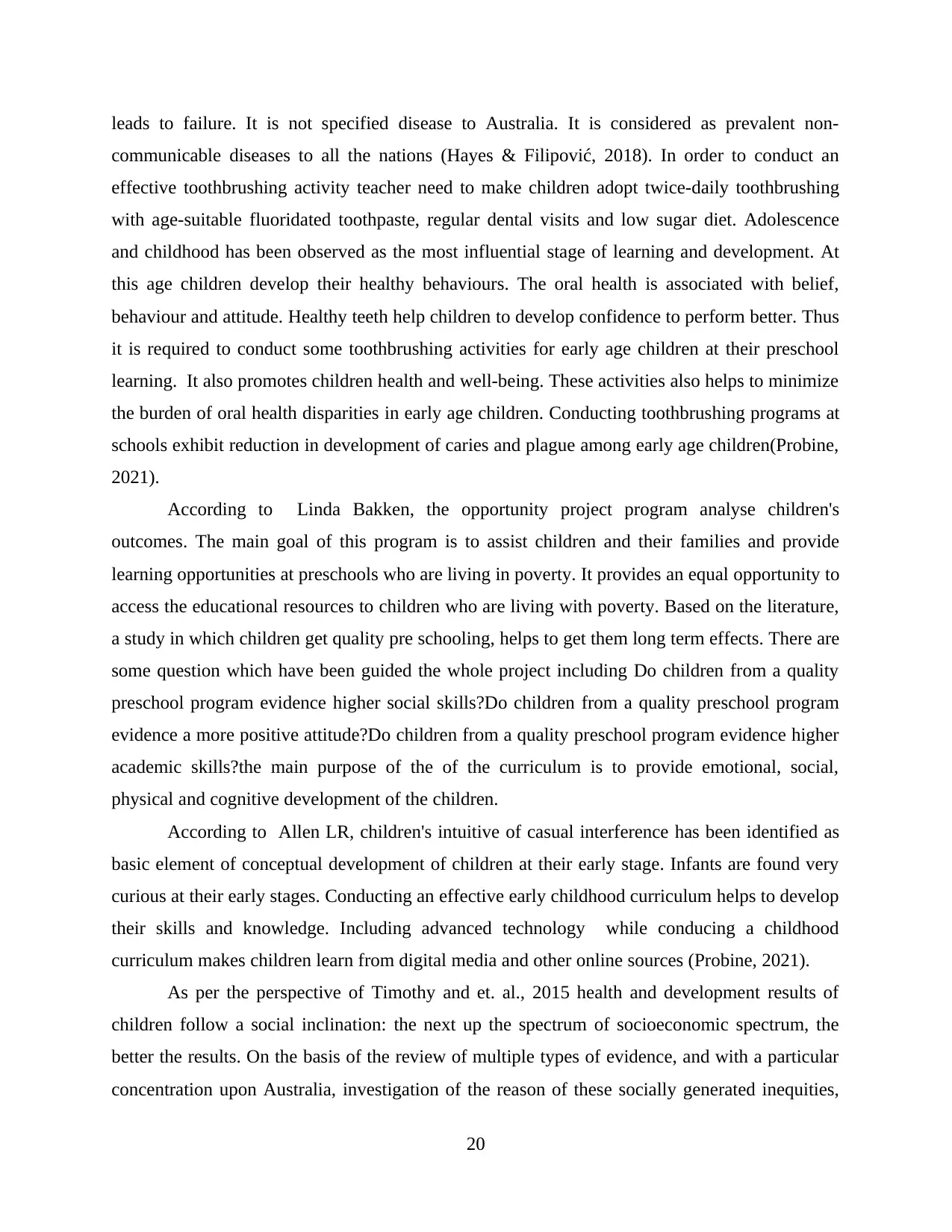
leads to failure. It is not specified disease to Australia. It is considered as prevalent non-
communicable diseases to all the nations (Hayes & Filipović, 2018). In order to conduct an
effective toothbrushing activity teacher need to make children adopt twice-daily toothbrushing
with age-suitable fluoridated toothpaste, regular dental visits and low sugar diet. Adolescence
and childhood has been observed as the most influential stage of learning and development. At
this age children develop their healthy behaviours. The oral health is associated with belief,
behaviour and attitude. Healthy teeth help children to develop confidence to perform better. Thus
it is required to conduct some toothbrushing activities for early age children at their preschool
learning. It also promotes children health and well-being. These activities also helps to minimize
the burden of oral health disparities in early age children. Conducting toothbrushing programs at
schools exhibit reduction in development of caries and plague among early age children(Probine,
2021).
According to Linda Bakken, the opportunity project program analyse children's
outcomes. The main goal of this program is to assist children and their families and provide
learning opportunities at preschools who are living in poverty. It provides an equal opportunity to
access the educational resources to children who are living with poverty. Based on the literature,
a study in which children get quality pre schooling, helps to get them long term effects. There are
some question which have been guided the whole project including Do children from a quality
preschool program evidence higher social skills?Do children from a quality preschool program
evidence a more positive attitude?Do children from a quality preschool program evidence higher
academic skills?the main purpose of the of the curriculum is to provide emotional, social,
physical and cognitive development of the children.
According to Allen LR, children's intuitive of casual interference has been identified as
basic element of conceptual development of children at their early stage. Infants are found very
curious at their early stages. Conducting an effective early childhood curriculum helps to develop
their skills and knowledge. Including advanced technology while conducing a childhood
curriculum makes children learn from digital media and other online sources (Probine, 2021).
As per the perspective of Timothy and et. al., 2015 health and development results of
children follow a social inclination: the next up the spectrum of socioeconomic spectrum, the
better the results. On the basis of the review of multiple types of evidence, and with a particular
concentration upon Australia, investigation of the reason of these socially generated inequities,
20
communicable diseases to all the nations (Hayes & Filipović, 2018). In order to conduct an
effective toothbrushing activity teacher need to make children adopt twice-daily toothbrushing
with age-suitable fluoridated toothpaste, regular dental visits and low sugar diet. Adolescence
and childhood has been observed as the most influential stage of learning and development. At
this age children develop their healthy behaviours. The oral health is associated with belief,
behaviour and attitude. Healthy teeth help children to develop confidence to perform better. Thus
it is required to conduct some toothbrushing activities for early age children at their preschool
learning. It also promotes children health and well-being. These activities also helps to minimize
the burden of oral health disparities in early age children. Conducting toothbrushing programs at
schools exhibit reduction in development of caries and plague among early age children(Probine,
2021).
According to Linda Bakken, the opportunity project program analyse children's
outcomes. The main goal of this program is to assist children and their families and provide
learning opportunities at preschools who are living in poverty. It provides an equal opportunity to
access the educational resources to children who are living with poverty. Based on the literature,
a study in which children get quality pre schooling, helps to get them long term effects. There are
some question which have been guided the whole project including Do children from a quality
preschool program evidence higher social skills?Do children from a quality preschool program
evidence a more positive attitude?Do children from a quality preschool program evidence higher
academic skills?the main purpose of the of the curriculum is to provide emotional, social,
physical and cognitive development of the children.
According to Allen LR, children's intuitive of casual interference has been identified as
basic element of conceptual development of children at their early stage. Infants are found very
curious at their early stages. Conducting an effective early childhood curriculum helps to develop
their skills and knowledge. Including advanced technology while conducing a childhood
curriculum makes children learn from digital media and other online sources (Probine, 2021).
As per the perspective of Timothy and et. al., 2015 health and development results of
children follow a social inclination: the next up the spectrum of socioeconomic spectrum, the
better the results. On the basis of the review of multiple types of evidence, and with a particular
concentration upon Australia, investigation of the reason of these socially generated inequities,
20
Secure Best Marks with AI Grader
Need help grading? Try our AI Grader for instant feedback on your assignments.
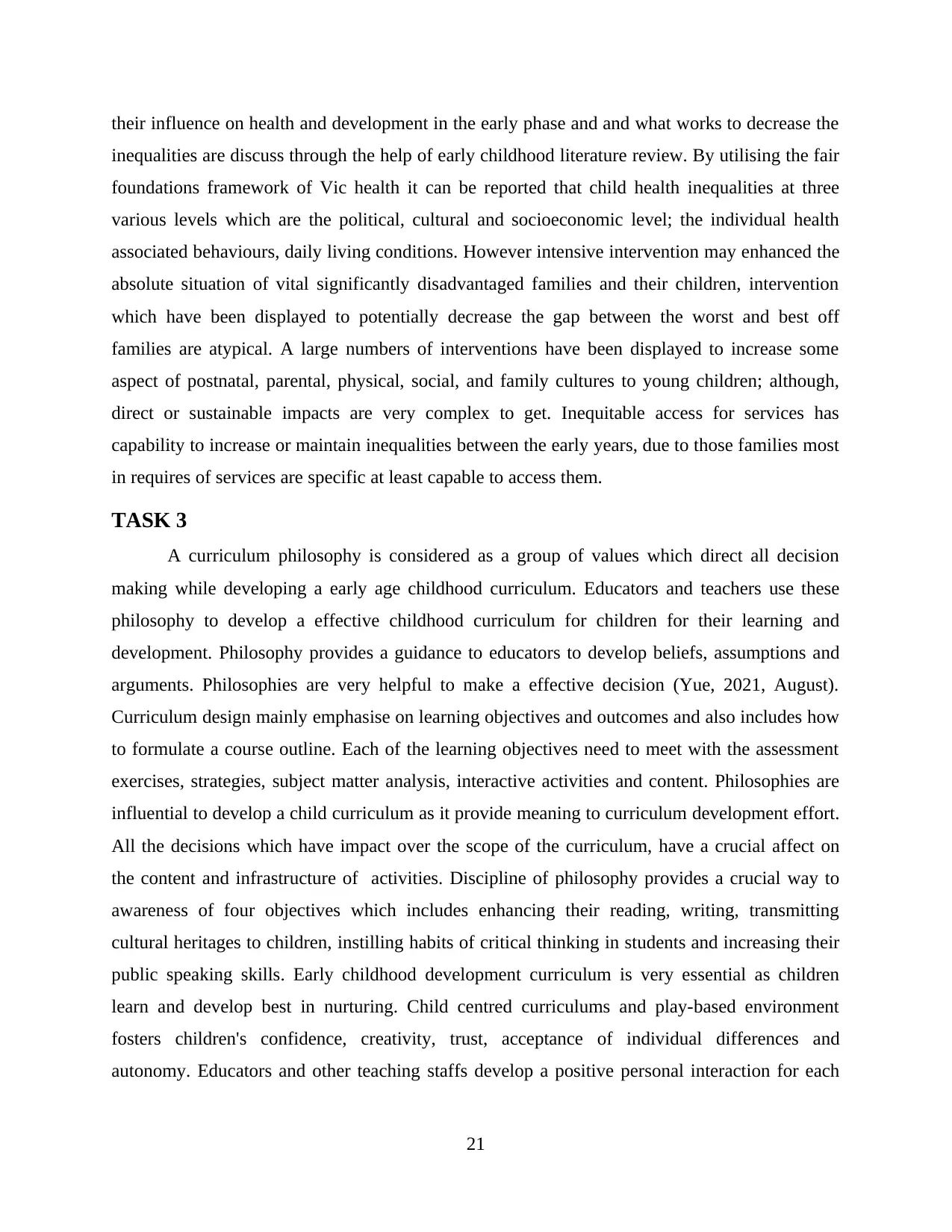
their influence on health and development in the early phase and and what works to decrease the
inequalities are discuss through the help of early childhood literature review. By utilising the fair
foundations framework of Vic health it can be reported that child health inequalities at three
various levels which are the political, cultural and socioeconomic level; the individual health
associated behaviours, daily living conditions. However intensive intervention may enhanced the
absolute situation of vital significantly disadvantaged families and their children, intervention
which have been displayed to potentially decrease the gap between the worst and best off
families are atypical. A large numbers of interventions have been displayed to increase some
aspect of postnatal, parental, physical, social, and family cultures to young children; although,
direct or sustainable impacts are very complex to get. Inequitable access for services has
capability to increase or maintain inequalities between the early years, due to those families most
in requires of services are specific at least capable to access them.
TASK 3
A curriculum philosophy is considered as a group of values which direct all decision
making while developing a early age childhood curriculum. Educators and teachers use these
philosophy to develop a effective childhood curriculum for children for their learning and
development. Philosophy provides a guidance to educators to develop beliefs, assumptions and
arguments. Philosophies are very helpful to make a effective decision (Yue, 2021, August).
Curriculum design mainly emphasise on learning objectives and outcomes and also includes how
to formulate a course outline. Each of the learning objectives need to meet with the assessment
exercises, strategies, subject matter analysis, interactive activities and content. Philosophies are
influential to develop a child curriculum as it provide meaning to curriculum development effort.
All the decisions which have impact over the scope of the curriculum, have a crucial affect on
the content and infrastructure of activities. Discipline of philosophy provides a crucial way to
awareness of four objectives which includes enhancing their reading, writing, transmitting
cultural heritages to children, instilling habits of critical thinking in students and increasing their
public speaking skills. Early childhood development curriculum is very essential as children
learn and develop best in nurturing. Child centred curriculums and play-based environment
fosters children's confidence, creativity, trust, acceptance of individual differences and
autonomy. Educators and other teaching staffs develop a positive personal interaction for each
21
inequalities are discuss through the help of early childhood literature review. By utilising the fair
foundations framework of Vic health it can be reported that child health inequalities at three
various levels which are the political, cultural and socioeconomic level; the individual health
associated behaviours, daily living conditions. However intensive intervention may enhanced the
absolute situation of vital significantly disadvantaged families and their children, intervention
which have been displayed to potentially decrease the gap between the worst and best off
families are atypical. A large numbers of interventions have been displayed to increase some
aspect of postnatal, parental, physical, social, and family cultures to young children; although,
direct or sustainable impacts are very complex to get. Inequitable access for services has
capability to increase or maintain inequalities between the early years, due to those families most
in requires of services are specific at least capable to access them.
TASK 3
A curriculum philosophy is considered as a group of values which direct all decision
making while developing a early age childhood curriculum. Educators and teachers use these
philosophy to develop a effective childhood curriculum for children for their learning and
development. Philosophy provides a guidance to educators to develop beliefs, assumptions and
arguments. Philosophies are very helpful to make a effective decision (Yue, 2021, August).
Curriculum design mainly emphasise on learning objectives and outcomes and also includes how
to formulate a course outline. Each of the learning objectives need to meet with the assessment
exercises, strategies, subject matter analysis, interactive activities and content. Philosophies are
influential to develop a child curriculum as it provide meaning to curriculum development effort.
All the decisions which have impact over the scope of the curriculum, have a crucial affect on
the content and infrastructure of activities. Discipline of philosophy provides a crucial way to
awareness of four objectives which includes enhancing their reading, writing, transmitting
cultural heritages to children, instilling habits of critical thinking in students and increasing their
public speaking skills. Early childhood development curriculum is very essential as children
learn and develop best in nurturing. Child centred curriculums and play-based environment
fosters children's confidence, creativity, trust, acceptance of individual differences and
autonomy. Educators and other teaching staffs develop a positive personal interaction for each
21
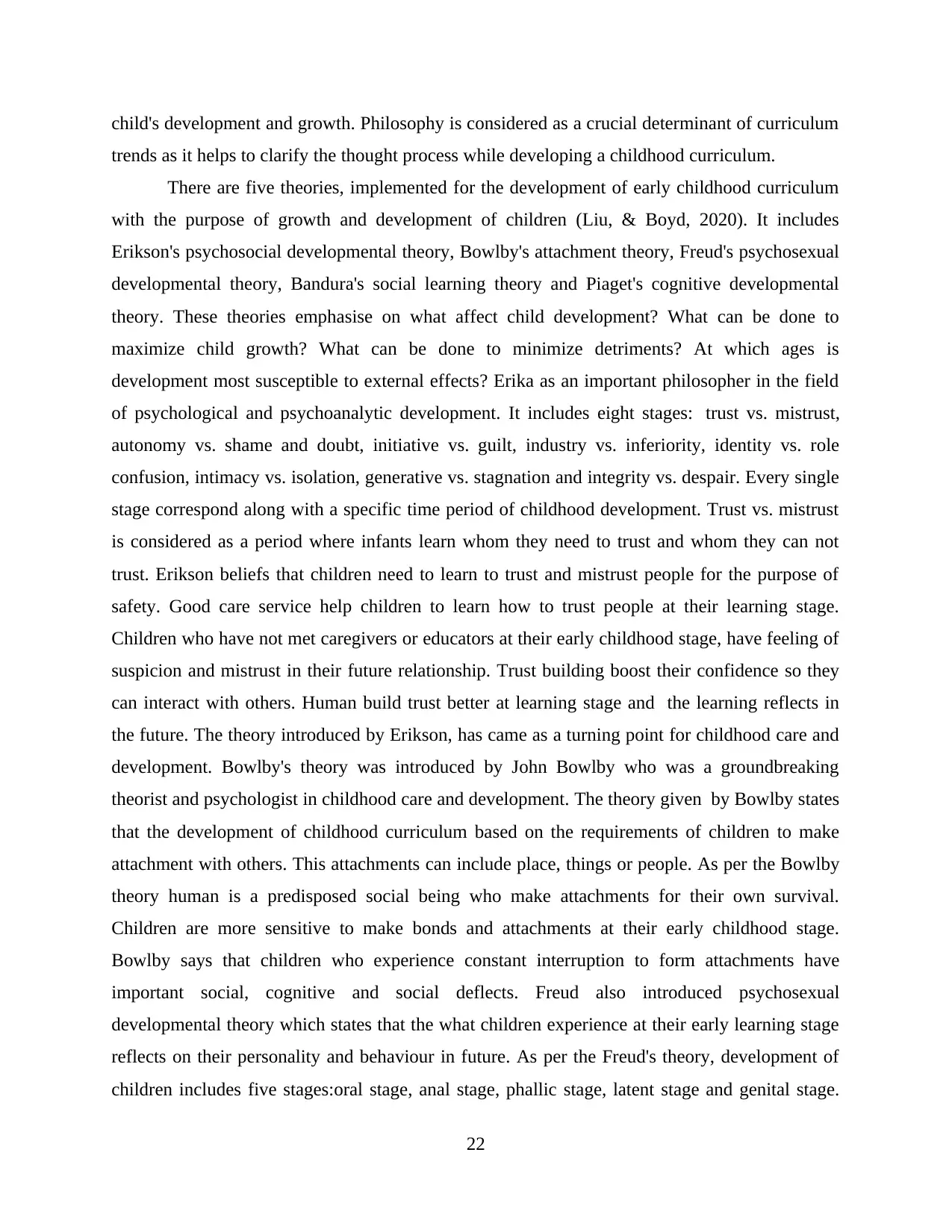
child's development and growth. Philosophy is considered as a crucial determinant of curriculum
trends as it helps to clarify the thought process while developing a childhood curriculum.
There are five theories, implemented for the development of early childhood curriculum
with the purpose of growth and development of children (Liu, & Boyd, 2020). It includes
Erikson's psychosocial developmental theory, Bowlby's attachment theory, Freud's psychosexual
developmental theory, Bandura's social learning theory and Piaget's cognitive developmental
theory. These theories emphasise on what affect child development? What can be done to
maximize child growth? What can be done to minimize detriments? At which ages is
development most susceptible to external effects? Erika as an important philosopher in the field
of psychological and psychoanalytic development. It includes eight stages: trust vs. mistrust,
autonomy vs. shame and doubt, initiative vs. guilt, industry vs. inferiority, identity vs. role
confusion, intimacy vs. isolation, generative vs. stagnation and integrity vs. despair. Every single
stage correspond along with a specific time period of childhood development. Trust vs. mistrust
is considered as a period where infants learn whom they need to trust and whom they can not
trust. Erikson beliefs that children need to learn to trust and mistrust people for the purpose of
safety. Good care service help children to learn how to trust people at their learning stage.
Children who have not met caregivers or educators at their early childhood stage, have feeling of
suspicion and mistrust in their future relationship. Trust building boost their confidence so they
can interact with others. Human build trust better at learning stage and the learning reflects in
the future. The theory introduced by Erikson, has came as a turning point for childhood care and
development. Bowlby's theory was introduced by John Bowlby who was a groundbreaking
theorist and psychologist in childhood care and development. The theory given by Bowlby states
that the development of childhood curriculum based on the requirements of children to make
attachment with others. This attachments can include place, things or people. As per the Bowlby
theory human is a predisposed social being who make attachments for their own survival.
Children are more sensitive to make bonds and attachments at their early childhood stage.
Bowlby says that children who experience constant interruption to form attachments have
important social, cognitive and social deflects. Freud also introduced psychosexual
developmental theory which states that the what children experience at their early learning stage
reflects on their personality and behaviour in future. As per the Freud's theory, development of
children includes five stages:oral stage, anal stage, phallic stage, latent stage and genital stage.
22
trends as it helps to clarify the thought process while developing a childhood curriculum.
There are five theories, implemented for the development of early childhood curriculum
with the purpose of growth and development of children (Liu, & Boyd, 2020). It includes
Erikson's psychosocial developmental theory, Bowlby's attachment theory, Freud's psychosexual
developmental theory, Bandura's social learning theory and Piaget's cognitive developmental
theory. These theories emphasise on what affect child development? What can be done to
maximize child growth? What can be done to minimize detriments? At which ages is
development most susceptible to external effects? Erika as an important philosopher in the field
of psychological and psychoanalytic development. It includes eight stages: trust vs. mistrust,
autonomy vs. shame and doubt, initiative vs. guilt, industry vs. inferiority, identity vs. role
confusion, intimacy vs. isolation, generative vs. stagnation and integrity vs. despair. Every single
stage correspond along with a specific time period of childhood development. Trust vs. mistrust
is considered as a period where infants learn whom they need to trust and whom they can not
trust. Erikson beliefs that children need to learn to trust and mistrust people for the purpose of
safety. Good care service help children to learn how to trust people at their learning stage.
Children who have not met caregivers or educators at their early childhood stage, have feeling of
suspicion and mistrust in their future relationship. Trust building boost their confidence so they
can interact with others. Human build trust better at learning stage and the learning reflects in
the future. The theory introduced by Erikson, has came as a turning point for childhood care and
development. Bowlby's theory was introduced by John Bowlby who was a groundbreaking
theorist and psychologist in childhood care and development. The theory given by Bowlby states
that the development of childhood curriculum based on the requirements of children to make
attachment with others. This attachments can include place, things or people. As per the Bowlby
theory human is a predisposed social being who make attachments for their own survival.
Children are more sensitive to make bonds and attachments at their early childhood stage.
Bowlby says that children who experience constant interruption to form attachments have
important social, cognitive and social deflects. Freud also introduced psychosexual
developmental theory which states that the what children experience at their early learning stage
reflects on their personality and behaviour in future. As per the Freud's theory, development of
children includes five stages:oral stage, anal stage, phallic stage, latent stage and genital stage.
22
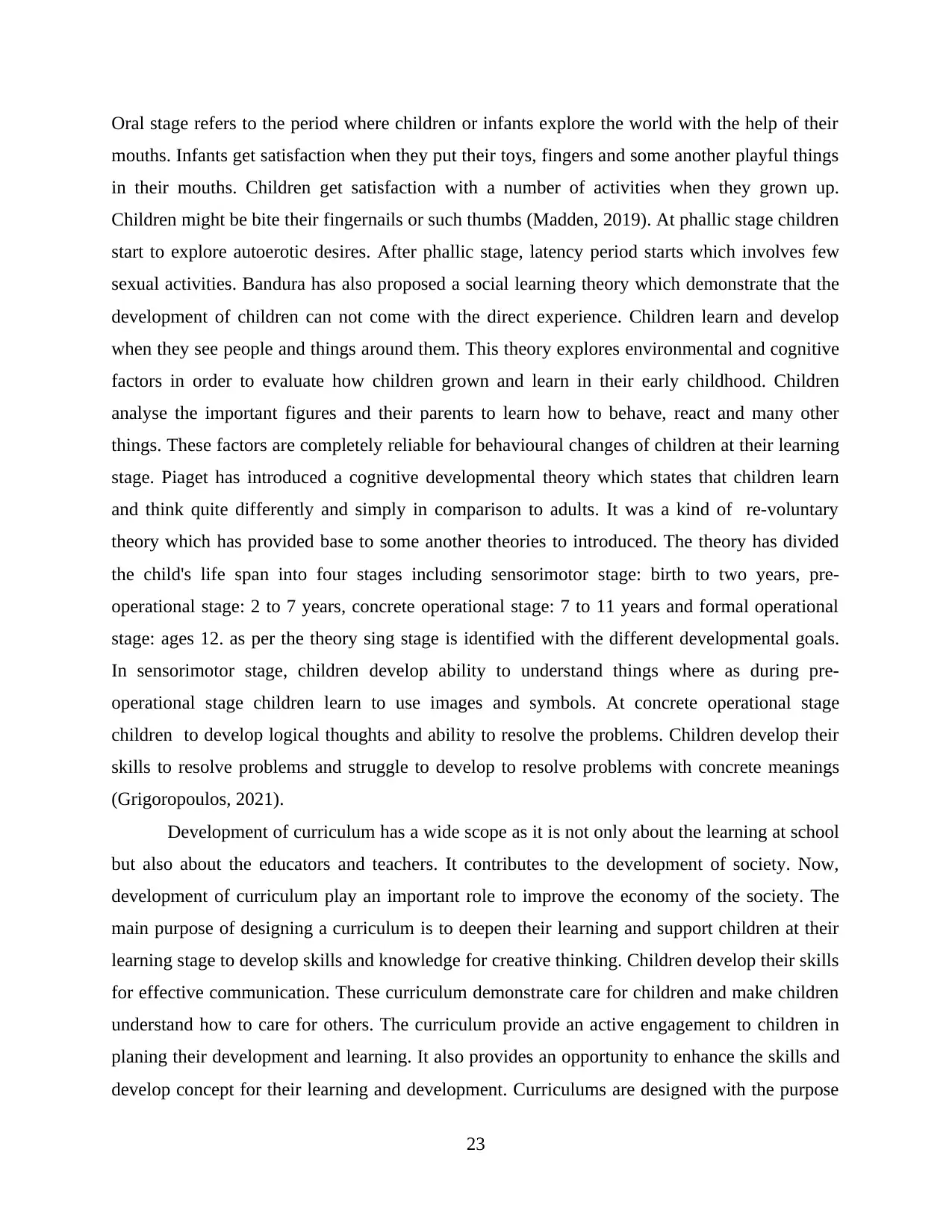
Oral stage refers to the period where children or infants explore the world with the help of their
mouths. Infants get satisfaction when they put their toys, fingers and some another playful things
in their mouths. Children get satisfaction with a number of activities when they grown up.
Children might be bite their fingernails or such thumbs (Madden, 2019). At phallic stage children
start to explore autoerotic desires. After phallic stage, latency period starts which involves few
sexual activities. Bandura has also proposed a social learning theory which demonstrate that the
development of children can not come with the direct experience. Children learn and develop
when they see people and things around them. This theory explores environmental and cognitive
factors in order to evaluate how children grown and learn in their early childhood. Children
analyse the important figures and their parents to learn how to behave, react and many other
things. These factors are completely reliable for behavioural changes of children at their learning
stage. Piaget has introduced a cognitive developmental theory which states that children learn
and think quite differently and simply in comparison to adults. It was a kind of re-voluntary
theory which has provided base to some another theories to introduced. The theory has divided
the child's life span into four stages including sensorimotor stage: birth to two years, pre-
operational stage: 2 to 7 years, concrete operational stage: 7 to 11 years and formal operational
stage: ages 12. as per the theory sing stage is identified with the different developmental goals.
In sensorimotor stage, children develop ability to understand things where as during pre-
operational stage children learn to use images and symbols. At concrete operational stage
children to develop logical thoughts and ability to resolve the problems. Children develop their
skills to resolve problems and struggle to develop to resolve problems with concrete meanings
(Grigoropoulos, 2021).
Development of curriculum has a wide scope as it is not only about the learning at school
but also about the educators and teachers. It contributes to the development of society. Now,
development of curriculum play an important role to improve the economy of the society. The
main purpose of designing a curriculum is to deepen their learning and support children at their
learning stage to develop skills and knowledge for creative thinking. Children develop their skills
for effective communication. These curriculum demonstrate care for children and make children
understand how to care for others. The curriculum provide an active engagement to children in
planing their development and learning. It also provides an opportunity to enhance the skills and
develop concept for their learning and development. Curriculums are designed with the purpose
23
mouths. Infants get satisfaction when they put their toys, fingers and some another playful things
in their mouths. Children get satisfaction with a number of activities when they grown up.
Children might be bite their fingernails or such thumbs (Madden, 2019). At phallic stage children
start to explore autoerotic desires. After phallic stage, latency period starts which involves few
sexual activities. Bandura has also proposed a social learning theory which demonstrate that the
development of children can not come with the direct experience. Children learn and develop
when they see people and things around them. This theory explores environmental and cognitive
factors in order to evaluate how children grown and learn in their early childhood. Children
analyse the important figures and their parents to learn how to behave, react and many other
things. These factors are completely reliable for behavioural changes of children at their learning
stage. Piaget has introduced a cognitive developmental theory which states that children learn
and think quite differently and simply in comparison to adults. It was a kind of re-voluntary
theory which has provided base to some another theories to introduced. The theory has divided
the child's life span into four stages including sensorimotor stage: birth to two years, pre-
operational stage: 2 to 7 years, concrete operational stage: 7 to 11 years and formal operational
stage: ages 12. as per the theory sing stage is identified with the different developmental goals.
In sensorimotor stage, children develop ability to understand things where as during pre-
operational stage children learn to use images and symbols. At concrete operational stage
children to develop logical thoughts and ability to resolve the problems. Children develop their
skills to resolve problems and struggle to develop to resolve problems with concrete meanings
(Grigoropoulos, 2021).
Development of curriculum has a wide scope as it is not only about the learning at school
but also about the educators and teachers. It contributes to the development of society. Now,
development of curriculum play an important role to improve the economy of the society. The
main purpose of designing a curriculum is to deepen their learning and support children at their
learning stage to develop skills and knowledge for creative thinking. Children develop their skills
for effective communication. These curriculum demonstrate care for children and make children
understand how to care for others. The curriculum provide an active engagement to children in
planing their development and learning. It also provides an opportunity to enhance the skills and
develop concept for their learning and development. Curriculums are designed with the purpose
23
Paraphrase This Document
Need a fresh take? Get an instant paraphrase of this document with our AI Paraphraser
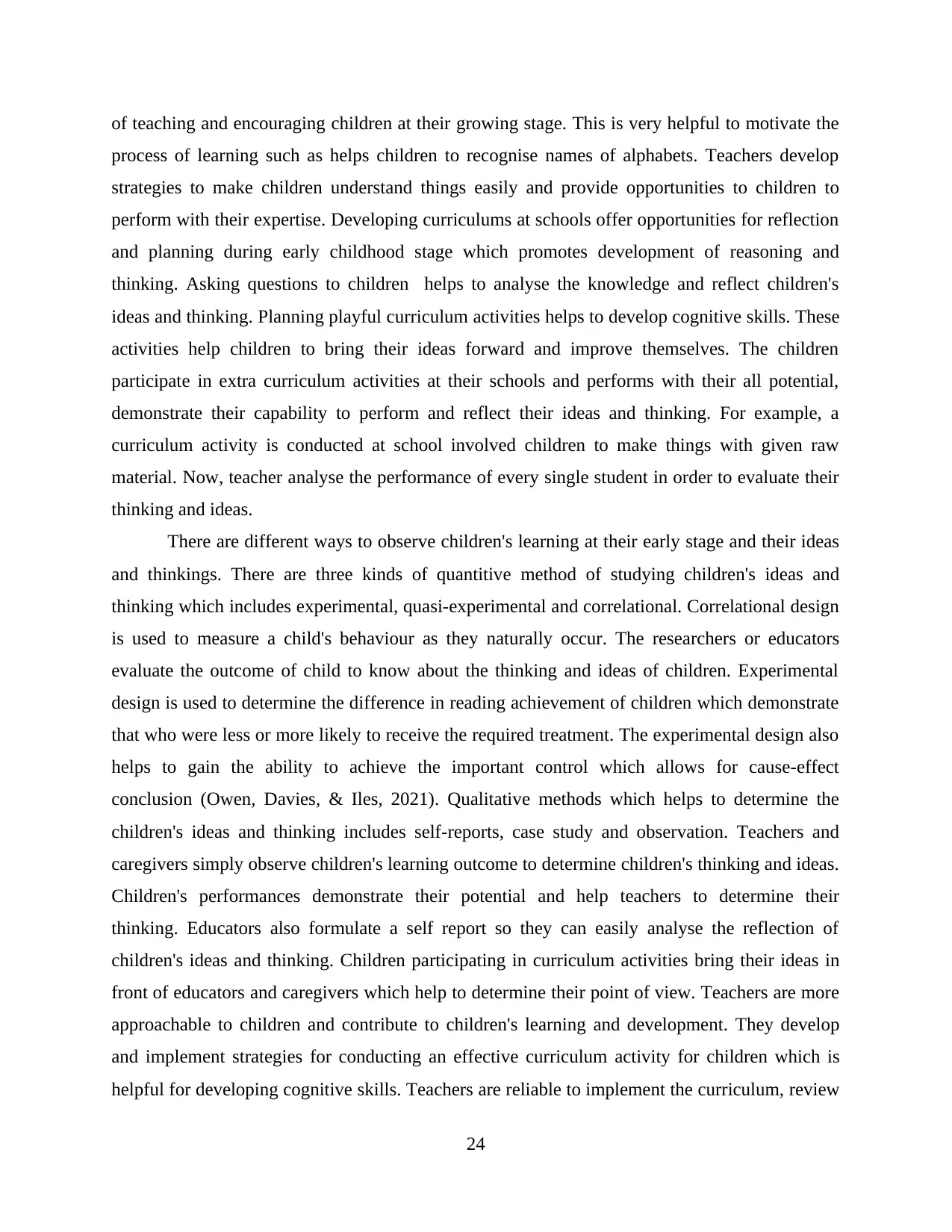
of teaching and encouraging children at their growing stage. This is very helpful to motivate the
process of learning such as helps children to recognise names of alphabets. Teachers develop
strategies to make children understand things easily and provide opportunities to children to
perform with their expertise. Developing curriculums at schools offer opportunities for reflection
and planning during early childhood stage which promotes development of reasoning and
thinking. Asking questions to children helps to analyse the knowledge and reflect children's
ideas and thinking. Planning playful curriculum activities helps to develop cognitive skills. These
activities help children to bring their ideas forward and improve themselves. The children
participate in extra curriculum activities at their schools and performs with their all potential,
demonstrate their capability to perform and reflect their ideas and thinking. For example, a
curriculum activity is conducted at school involved children to make things with given raw
material. Now, teacher analyse the performance of every single student in order to evaluate their
thinking and ideas.
There are different ways to observe children's learning at their early stage and their ideas
and thinkings. There are three kinds of quantitive method of studying children's ideas and
thinking which includes experimental, quasi-experimental and correlational. Correlational design
is used to measure a child's behaviour as they naturally occur. The researchers or educators
evaluate the outcome of child to know about the thinking and ideas of children. Experimental
design is used to determine the difference in reading achievement of children which demonstrate
that who were less or more likely to receive the required treatment. The experimental design also
helps to gain the ability to achieve the important control which allows for cause-effect
conclusion (Owen, Davies, & Iles, 2021). Qualitative methods which helps to determine the
children's ideas and thinking includes self-reports, case study and observation. Teachers and
caregivers simply observe children's learning outcome to determine children's thinking and ideas.
Children's performances demonstrate their potential and help teachers to determine their
thinking. Educators also formulate a self report so they can easily analyse the reflection of
children's ideas and thinking. Children participating in curriculum activities bring their ideas in
front of educators and caregivers which help to determine their point of view. Teachers are more
approachable to children and contribute to children's learning and development. They develop
and implement strategies for conducting an effective curriculum activity for children which is
helpful for developing cognitive skills. Teachers are reliable to implement the curriculum, review
24
process of learning such as helps children to recognise names of alphabets. Teachers develop
strategies to make children understand things easily and provide opportunities to children to
perform with their expertise. Developing curriculums at schools offer opportunities for reflection
and planning during early childhood stage which promotes development of reasoning and
thinking. Asking questions to children helps to analyse the knowledge and reflect children's
ideas and thinking. Planning playful curriculum activities helps to develop cognitive skills. These
activities help children to bring their ideas forward and improve themselves. The children
participate in extra curriculum activities at their schools and performs with their all potential,
demonstrate their capability to perform and reflect their ideas and thinking. For example, a
curriculum activity is conducted at school involved children to make things with given raw
material. Now, teacher analyse the performance of every single student in order to evaluate their
thinking and ideas.
There are different ways to observe children's learning at their early stage and their ideas
and thinkings. There are three kinds of quantitive method of studying children's ideas and
thinking which includes experimental, quasi-experimental and correlational. Correlational design
is used to measure a child's behaviour as they naturally occur. The researchers or educators
evaluate the outcome of child to know about the thinking and ideas of children. Experimental
design is used to determine the difference in reading achievement of children which demonstrate
that who were less or more likely to receive the required treatment. The experimental design also
helps to gain the ability to achieve the important control which allows for cause-effect
conclusion (Owen, Davies, & Iles, 2021). Qualitative methods which helps to determine the
children's ideas and thinking includes self-reports, case study and observation. Teachers and
caregivers simply observe children's learning outcome to determine children's thinking and ideas.
Children's performances demonstrate their potential and help teachers to determine their
thinking. Educators also formulate a self report so they can easily analyse the reflection of
children's ideas and thinking. Children participating in curriculum activities bring their ideas in
front of educators and caregivers which help to determine their point of view. Teachers are more
approachable to children and contribute to children's learning and development. They develop
and implement strategies for conducting an effective curriculum activity for children which is
helpful for developing cognitive skills. Teachers are reliable to implement the curriculum, review
24
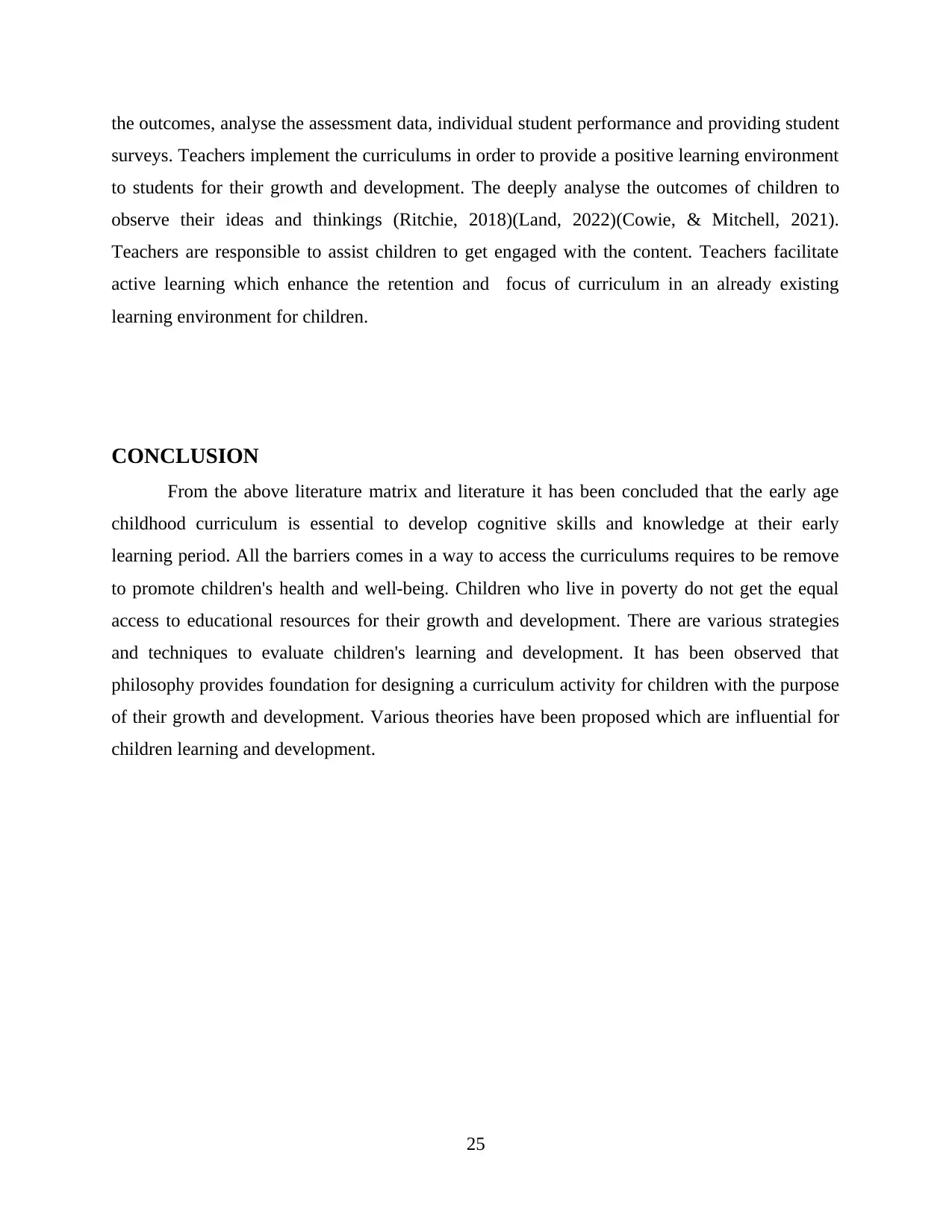
the outcomes, analyse the assessment data, individual student performance and providing student
surveys. Teachers implement the curriculums in order to provide a positive learning environment
to students for their growth and development. The deeply analyse the outcomes of children to
observe their ideas and thinkings (Ritchie, 2018)(Land, 2022)(Cowie, & Mitchell, 2021).
Teachers are responsible to assist children to get engaged with the content. Teachers facilitate
active learning which enhance the retention and focus of curriculum in an already existing
learning environment for children.
CONCLUSION
From the above literature matrix and literature it has been concluded that the early age
childhood curriculum is essential to develop cognitive skills and knowledge at their early
learning period. All the barriers comes in a way to access the curriculums requires to be remove
to promote children's health and well-being. Children who live in poverty do not get the equal
access to educational resources for their growth and development. There are various strategies
and techniques to evaluate children's learning and development. It has been observed that
philosophy provides foundation for designing a curriculum activity for children with the purpose
of their growth and development. Various theories have been proposed which are influential for
children learning and development.
25
surveys. Teachers implement the curriculums in order to provide a positive learning environment
to students for their growth and development. The deeply analyse the outcomes of children to
observe their ideas and thinkings (Ritchie, 2018)(Land, 2022)(Cowie, & Mitchell, 2021).
Teachers are responsible to assist children to get engaged with the content. Teachers facilitate
active learning which enhance the retention and focus of curriculum in an already existing
learning environment for children.
CONCLUSION
From the above literature matrix and literature it has been concluded that the early age
childhood curriculum is essential to develop cognitive skills and knowledge at their early
learning period. All the barriers comes in a way to access the curriculums requires to be remove
to promote children's health and well-being. Children who live in poverty do not get the equal
access to educational resources for their growth and development. There are various strategies
and techniques to evaluate children's learning and development. It has been observed that
philosophy provides foundation for designing a curriculum activity for children with the purpose
of their growth and development. Various theories have been proposed which are influential for
children learning and development.
25
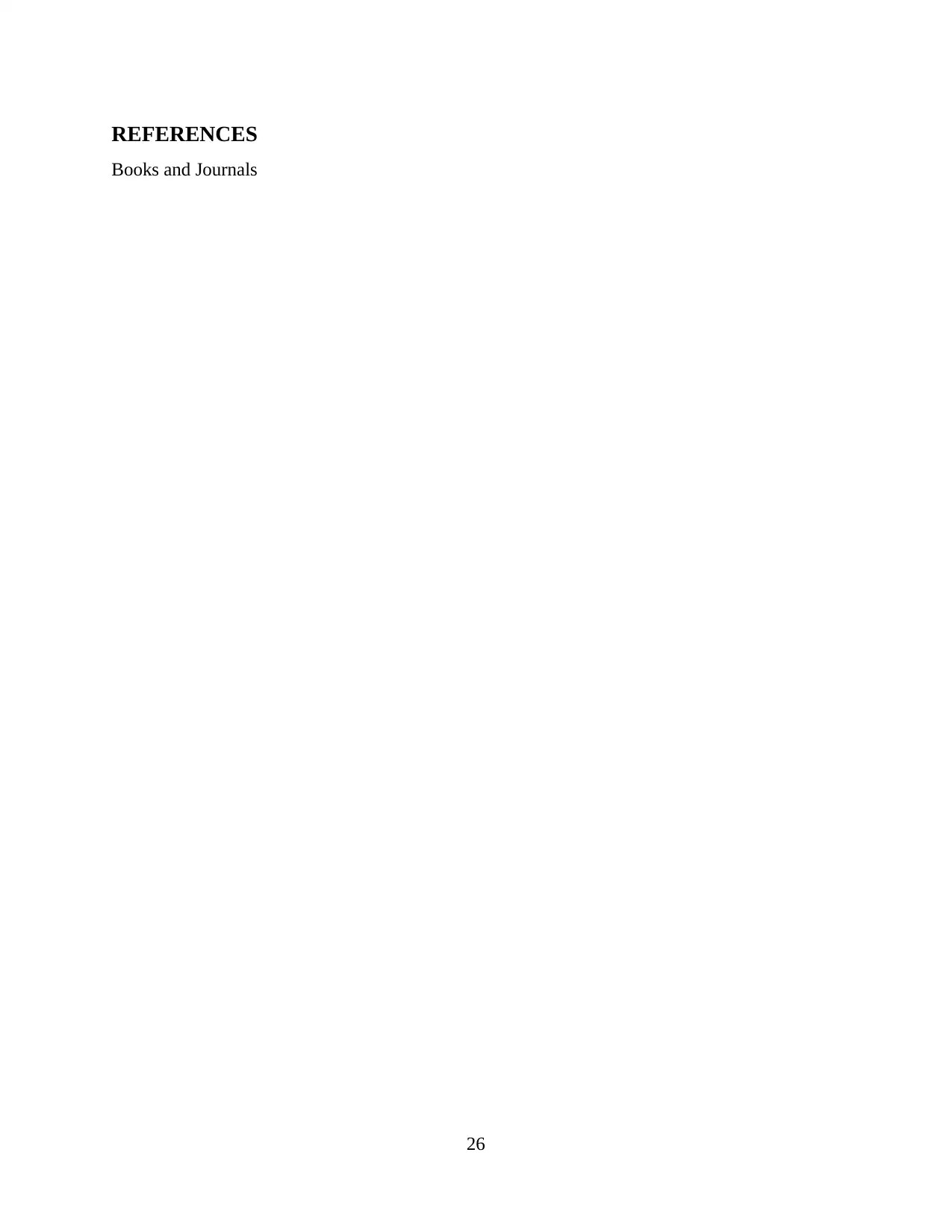
REFERENCES
Books and Journals
26
Books and Journals
26
Secure Best Marks with AI Grader
Need help grading? Try our AI Grader for instant feedback on your assignments.

27
1 out of 29
Related Documents
Your All-in-One AI-Powered Toolkit for Academic Success.
+13062052269
info@desklib.com
Available 24*7 on WhatsApp / Email
![[object Object]](/_next/static/media/star-bottom.7253800d.svg)
Unlock your academic potential
© 2024 | Zucol Services PVT LTD | All rights reserved.





